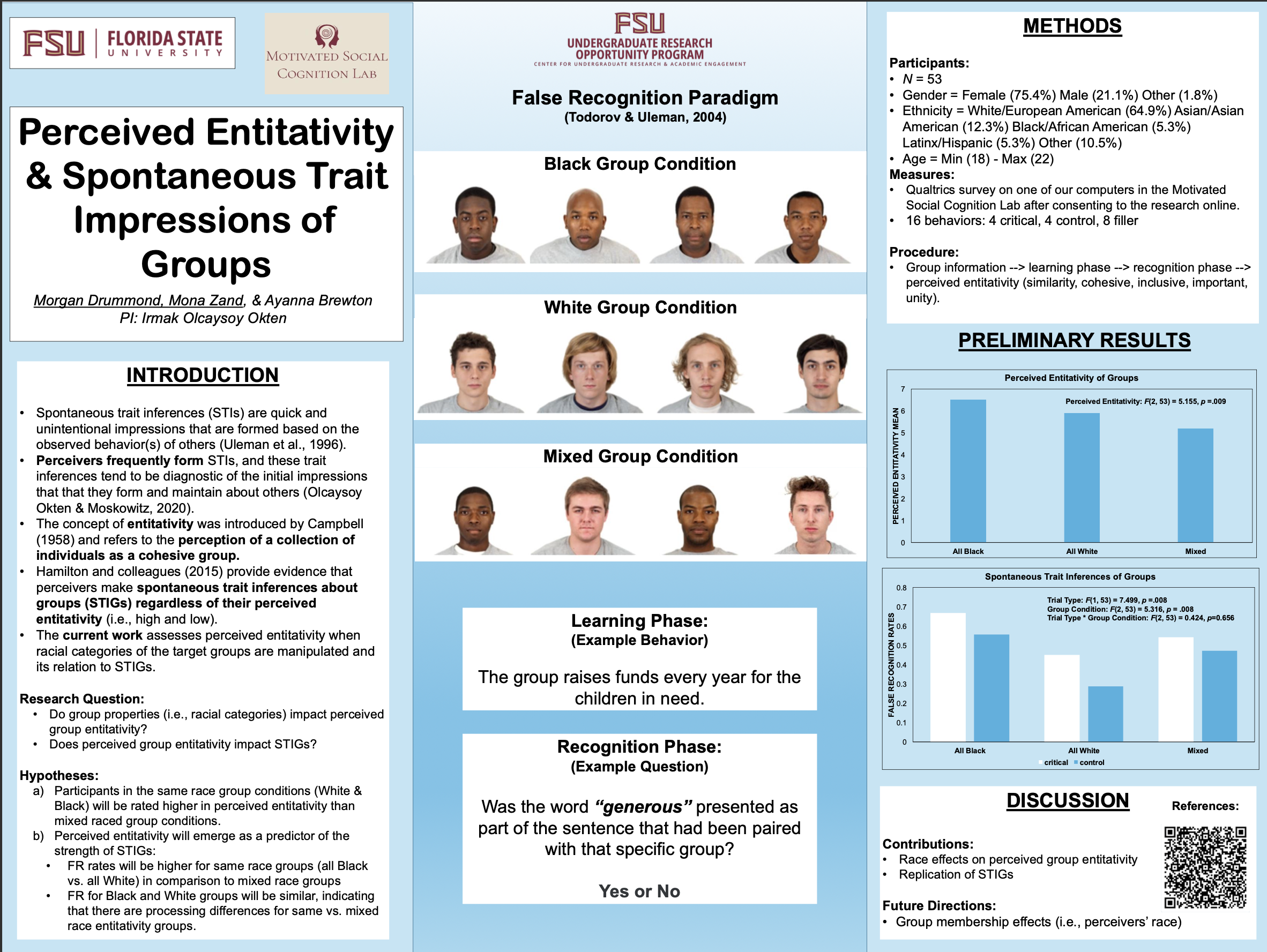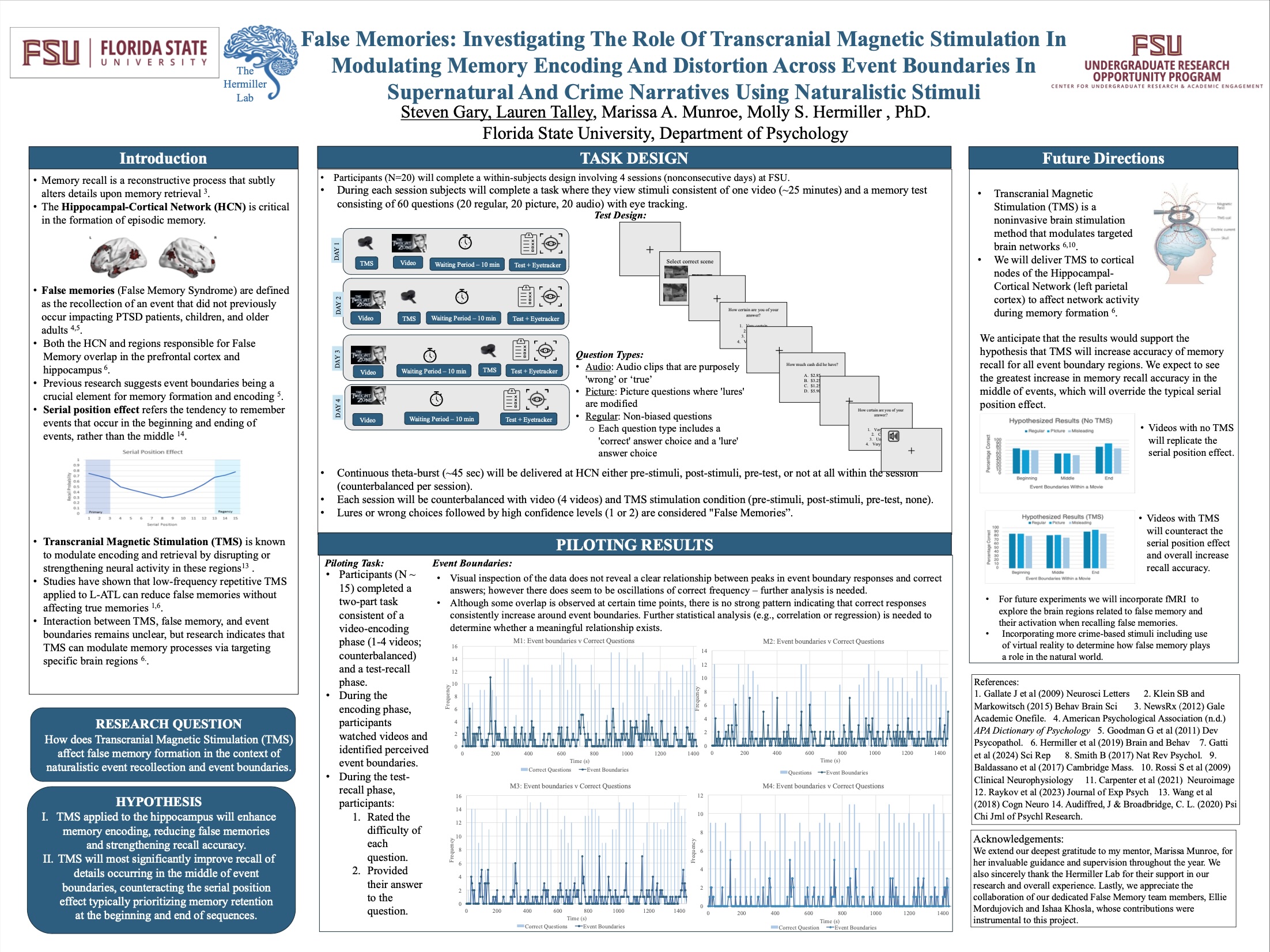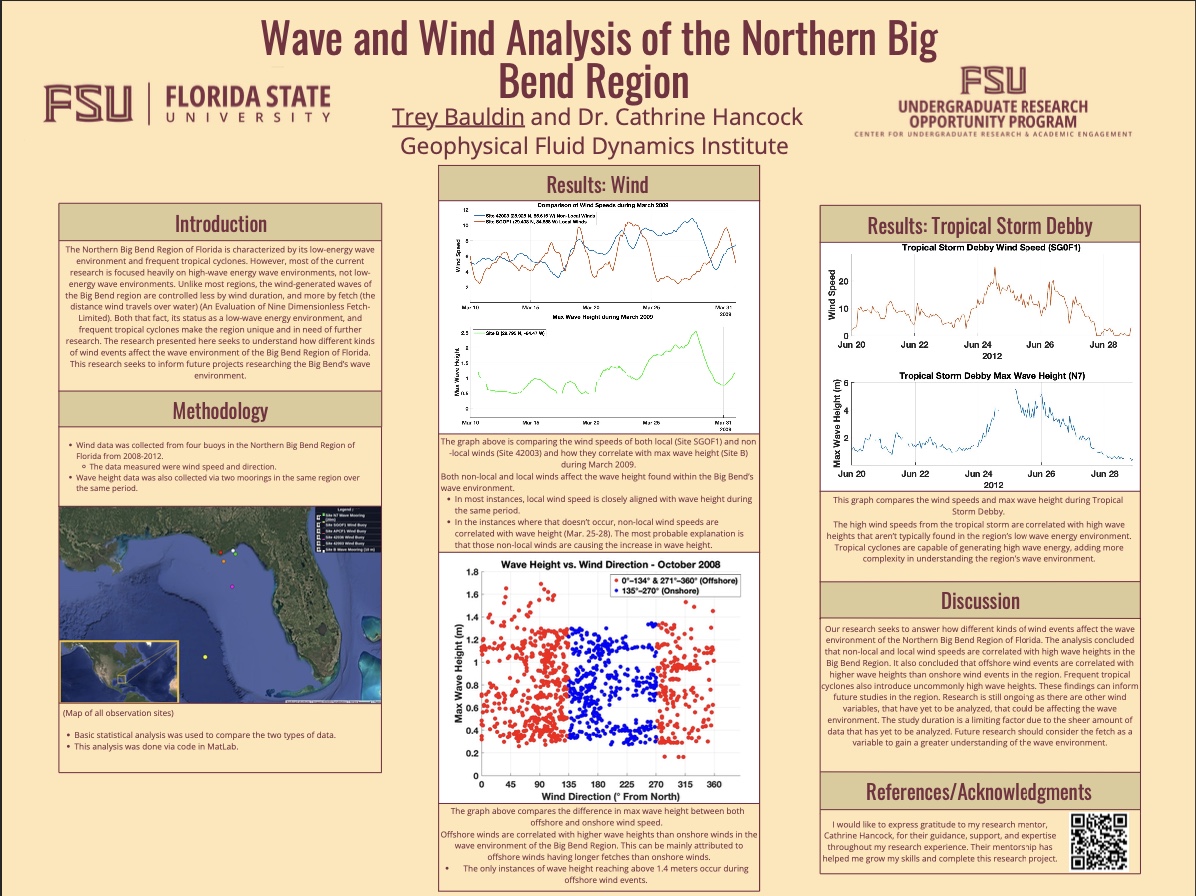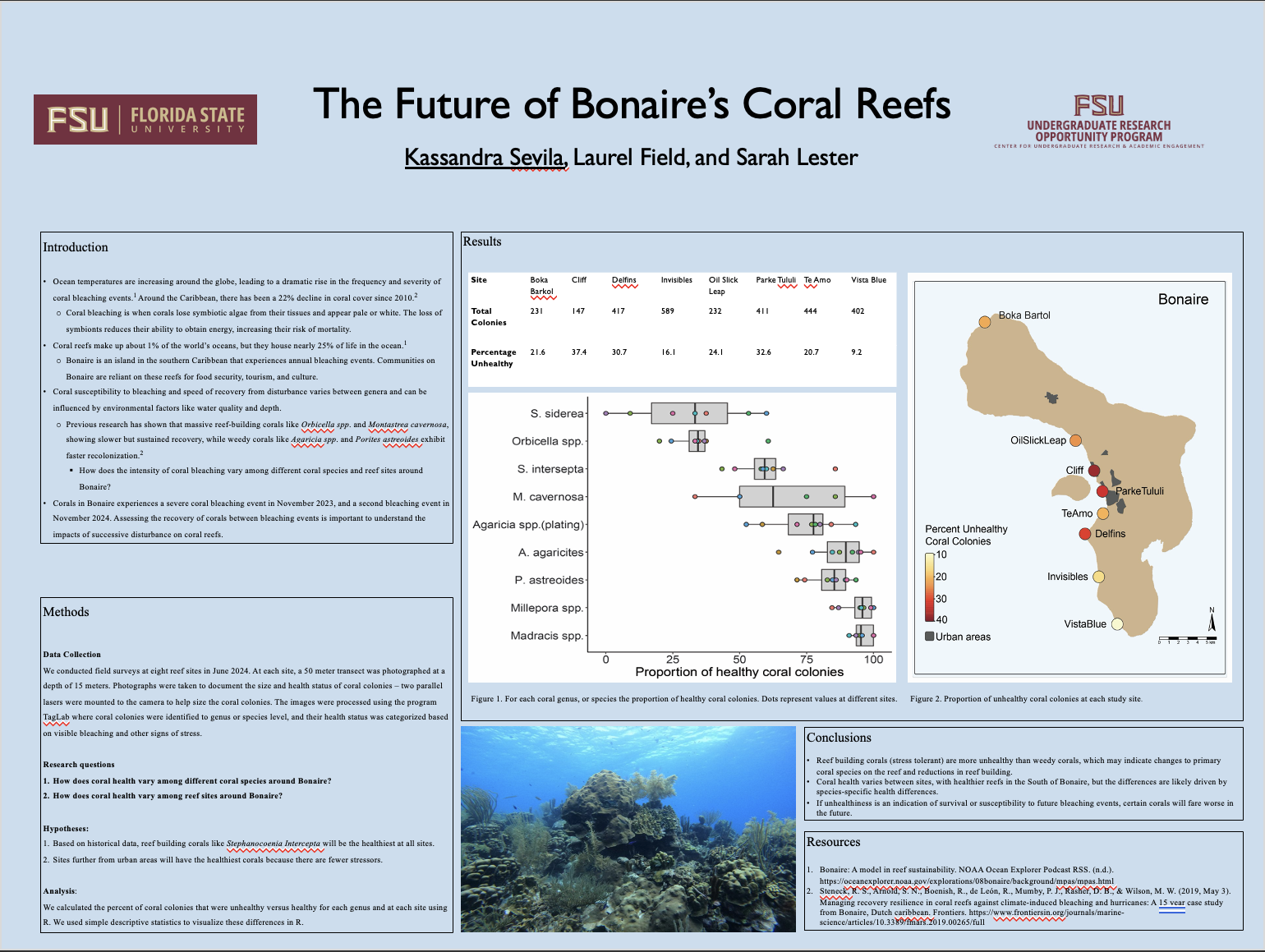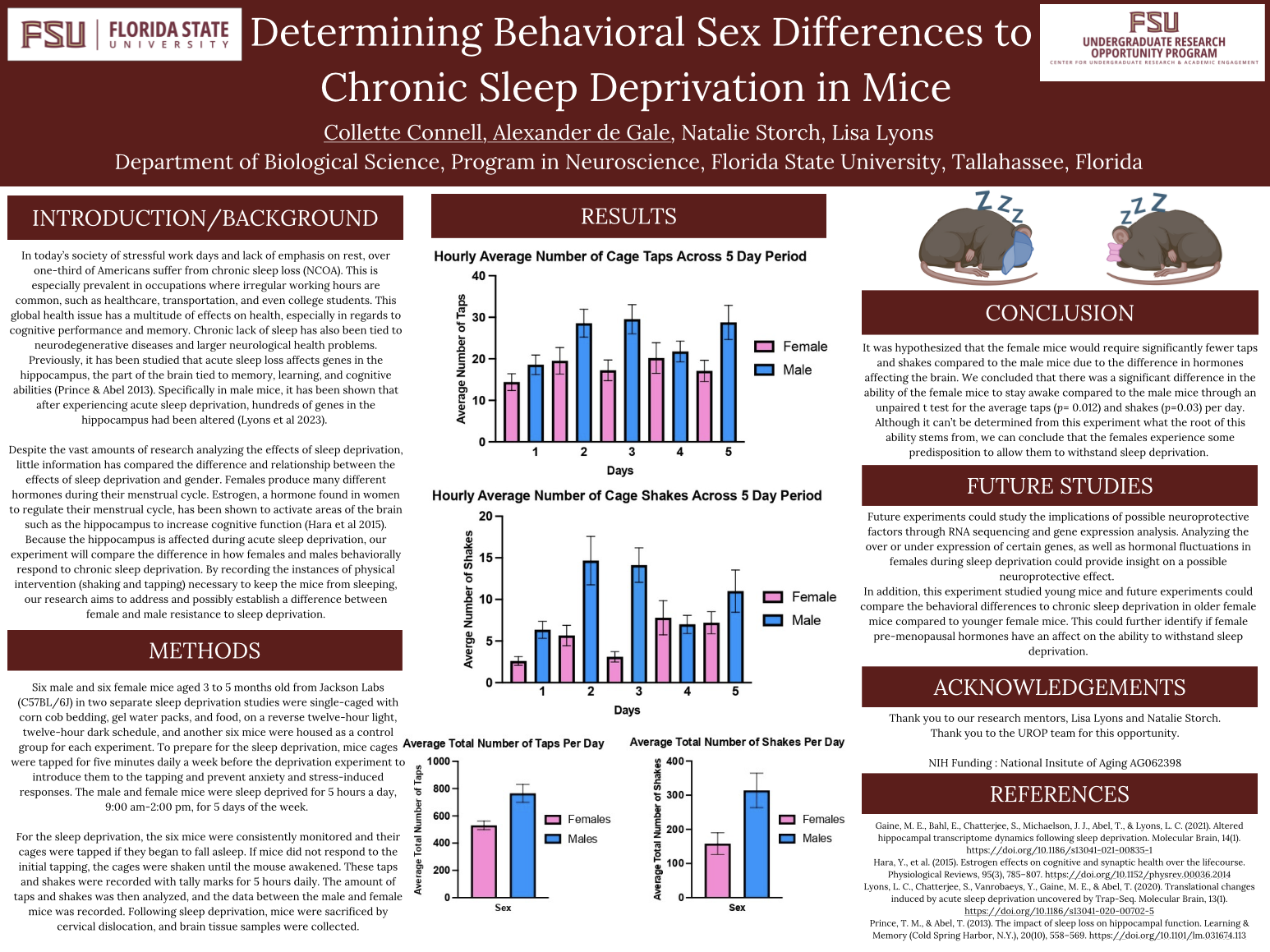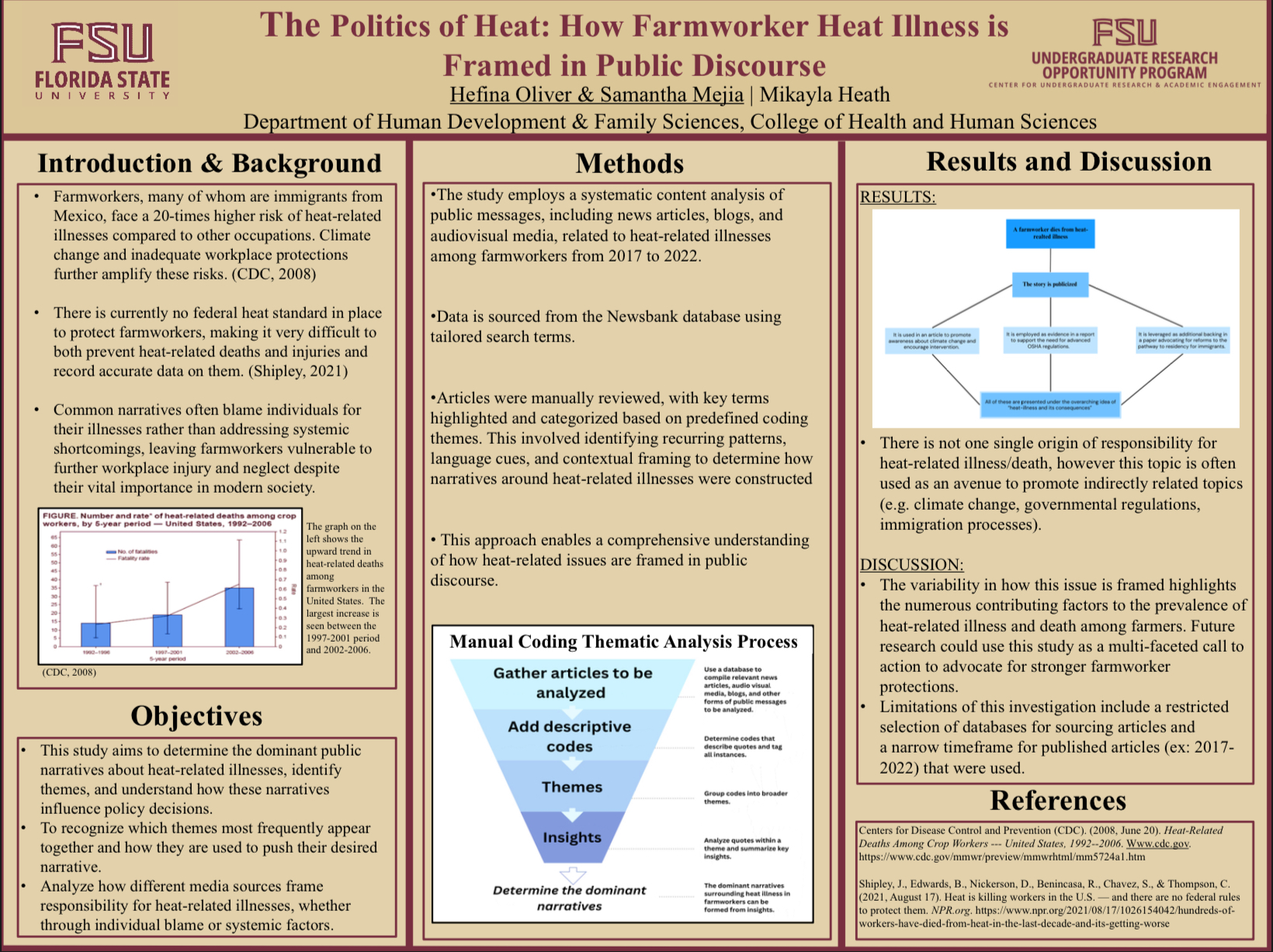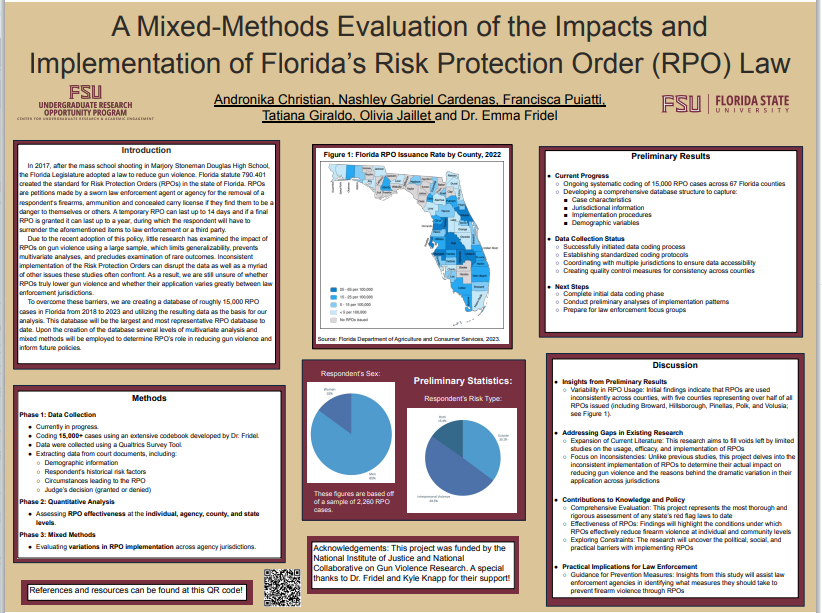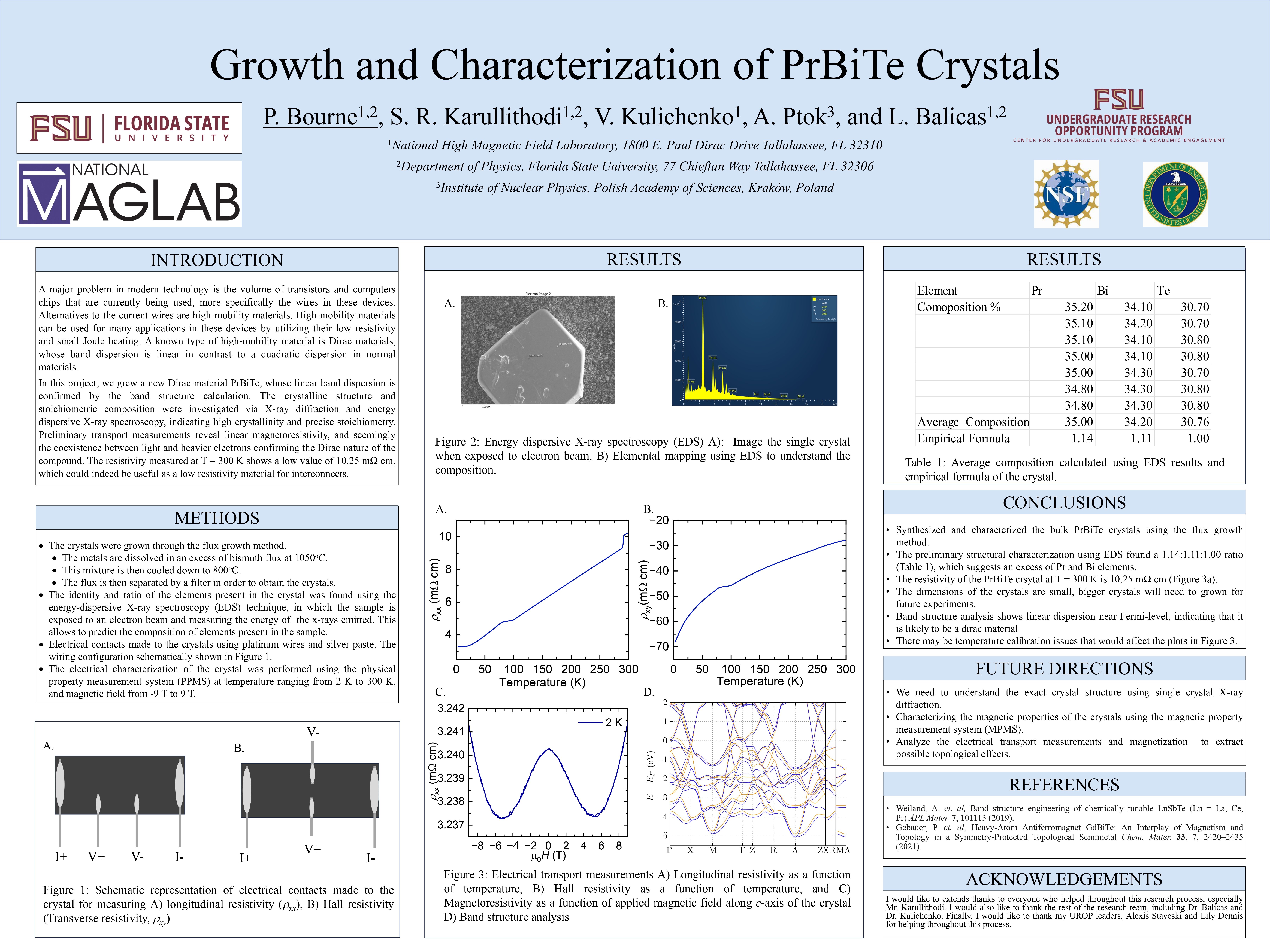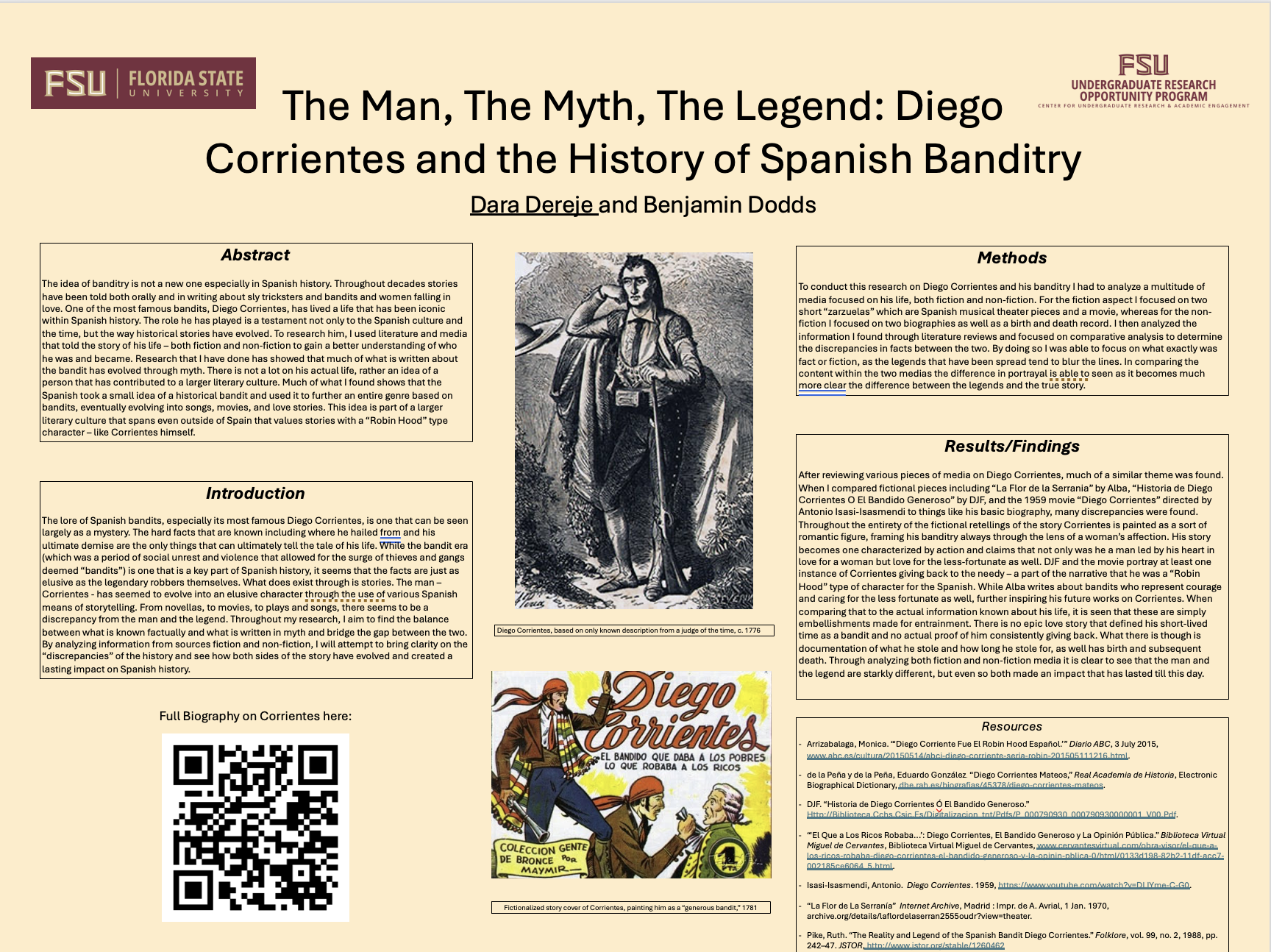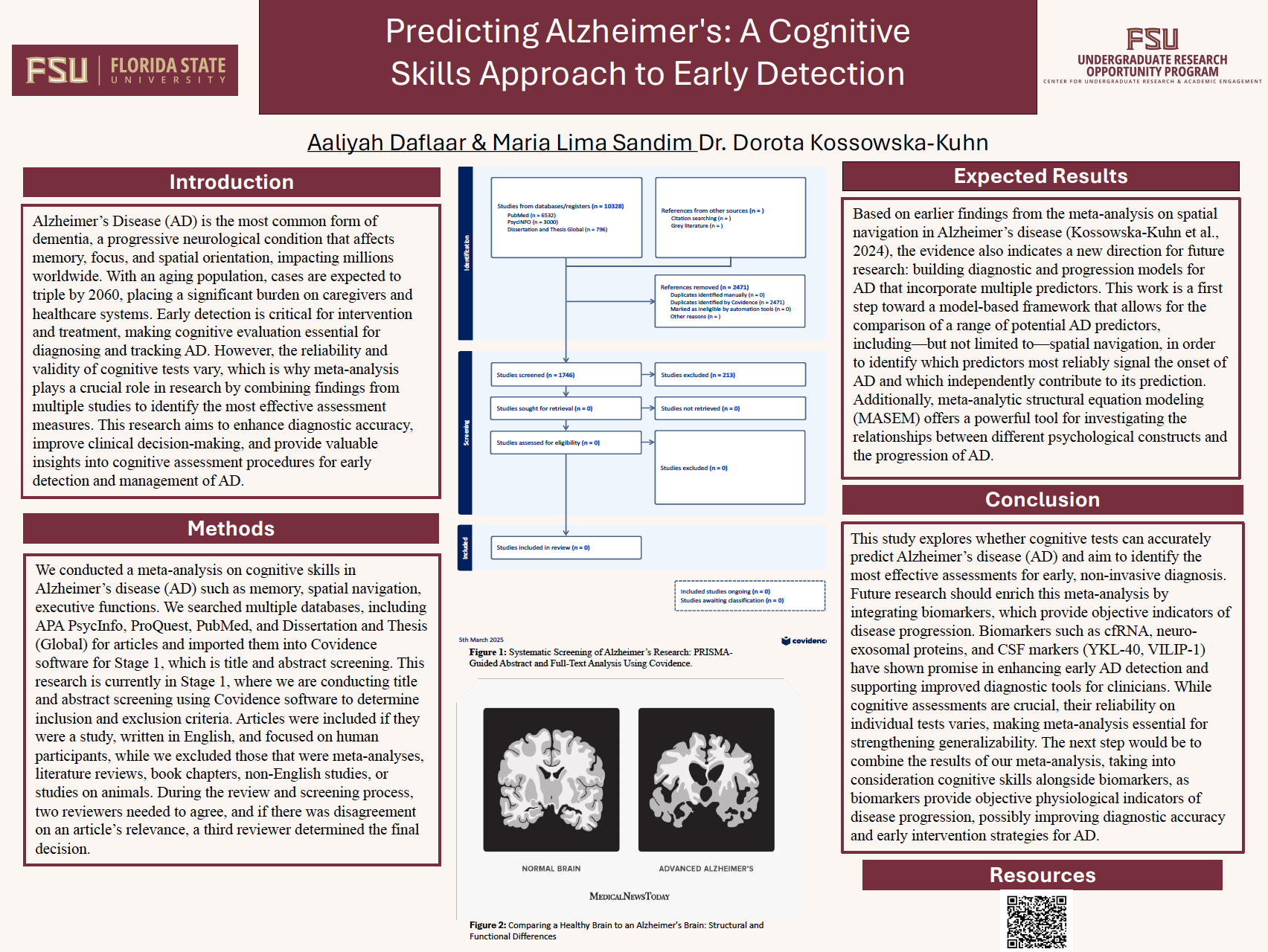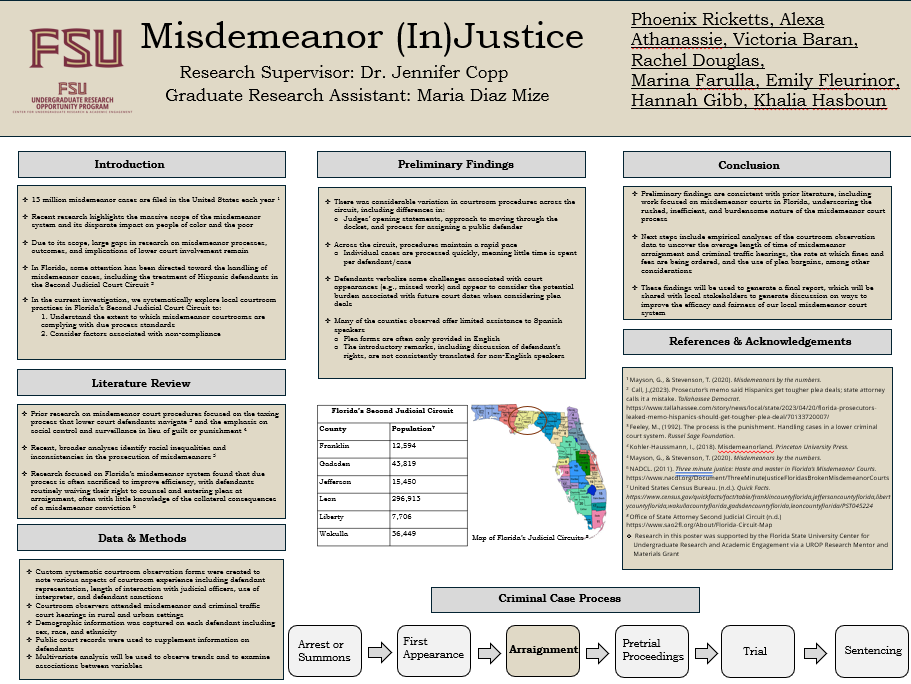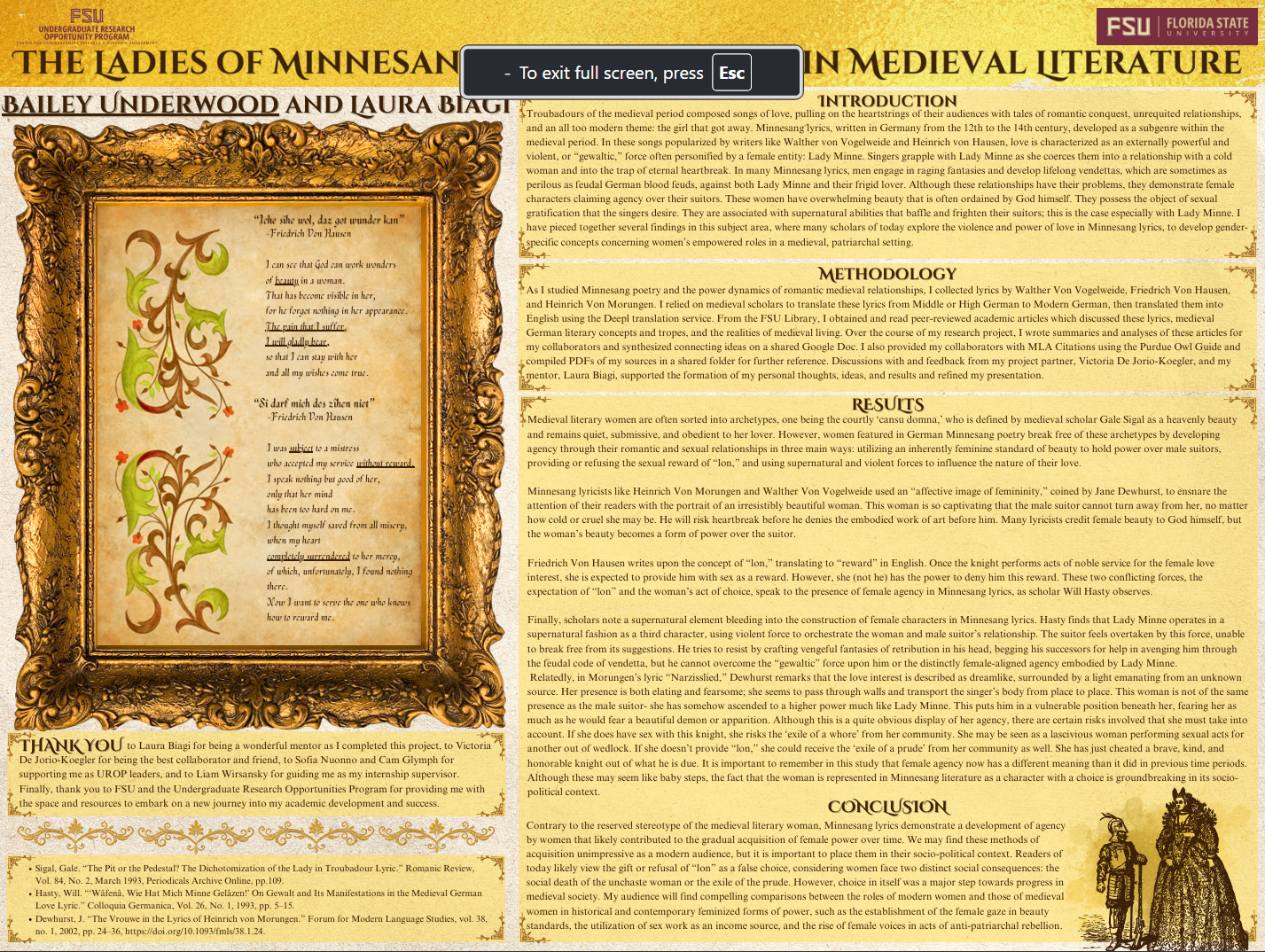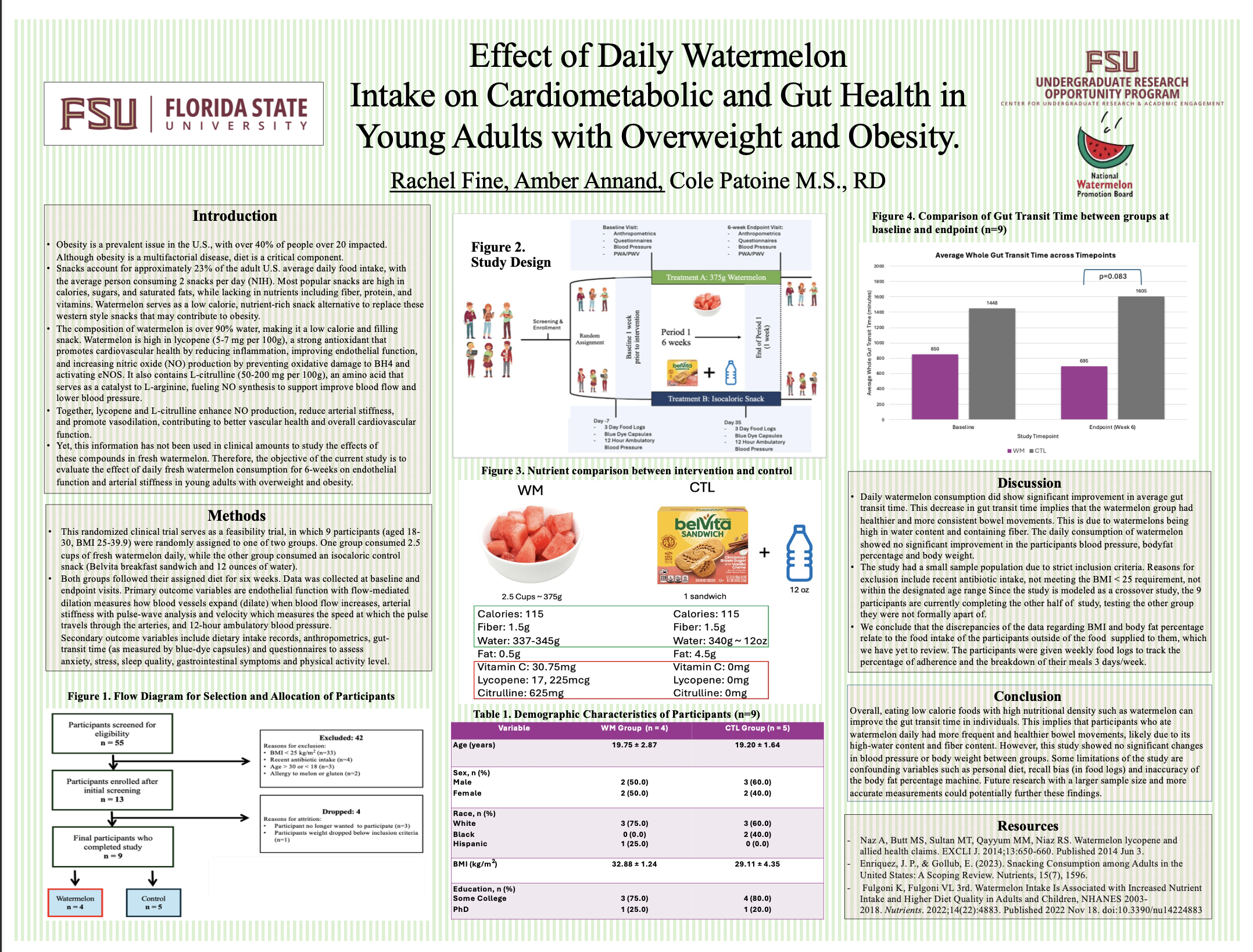Research Symposium
25th annual Undergraduate Research Symposium, April 1, 2025
Mona Zand Poster Session 2: 10:45 am - 11:45 am/ Poster #180
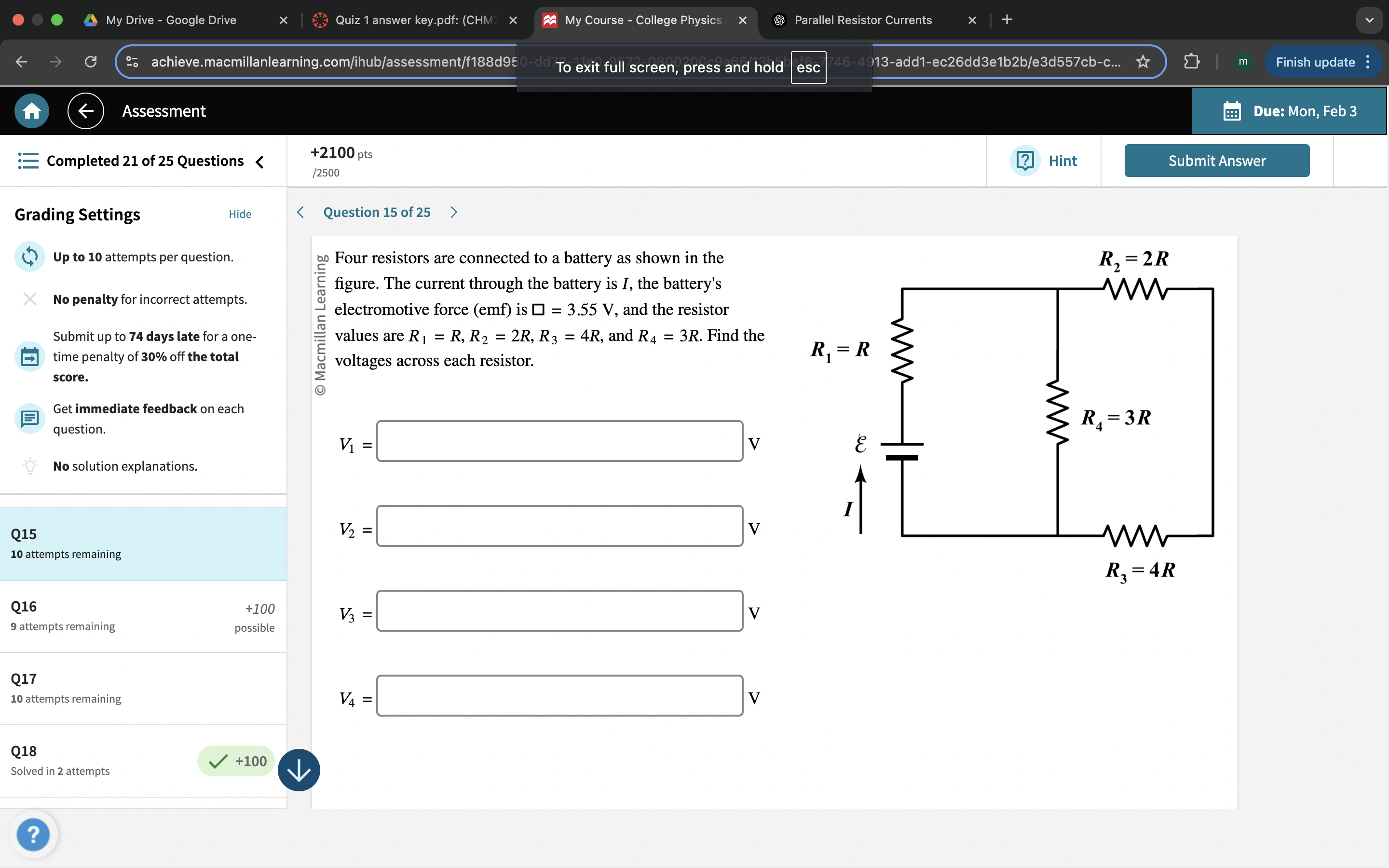
BIO
My name is Mona, and I am a behavioral neuroscience major from Clarksville, Maryland. I have a particular interest in researching social and behavioral psychology, and how this could be applied to medicine and the medical field in general. I will be attending medical school in the future in hopes of becoming a physician.
Perceived Entitativity & Spontaneous Trait Impressions of Groups
Authors: Mona Zand, Ayanna BrewtonStudent Major: Behavioral Neuroscience
Mentor: Ayanna Brewton
Mentor's Department: Psychology Mentor's College: College of Arts and Sciences Co-Presenters: Morgan Drummond
Abstract
It is understood, in person perception research, that perceivers frequently form unintentional spontaneous trait inferences (STIs) based on the observed behavior of others (Uleman et al., 1996), and these trait inferences tend to be diagnostic of the initial impressions that we form and maintain about others (Olcaysoy Okten & Moskowitz, 2020). Similarly, Hamilton and colleagues (2015) provide evidence that perceivers also make spontaneous trait inferences about groups (STIGs). Particularly, they found that STIGs are not affected by cognitive load, occur for high and low entitativity groups, are diagnostic of impression ratings, and generalizable to new group members. The proposed research project extends the research initiatives of Hamilton et al., (2015) study by building onto their target group manipulation. The purpose of the current research project is to design a manipulation of perceived entitativity by adding racial categories to target groups (All Black/ All White/ Combination of Black and White). This research project will contribute to the field’s limited understanding of STIGs through its addition of perceived group homogeneity, ethnicity, and group membership effects.
Keywords: Spontaneous trait inferences
25th annual Undergraduate Research Symposium, April 1, 2025
Lauren Talley Poster Session 3: 1:45 pm - 2:45 pm/ Poster #218
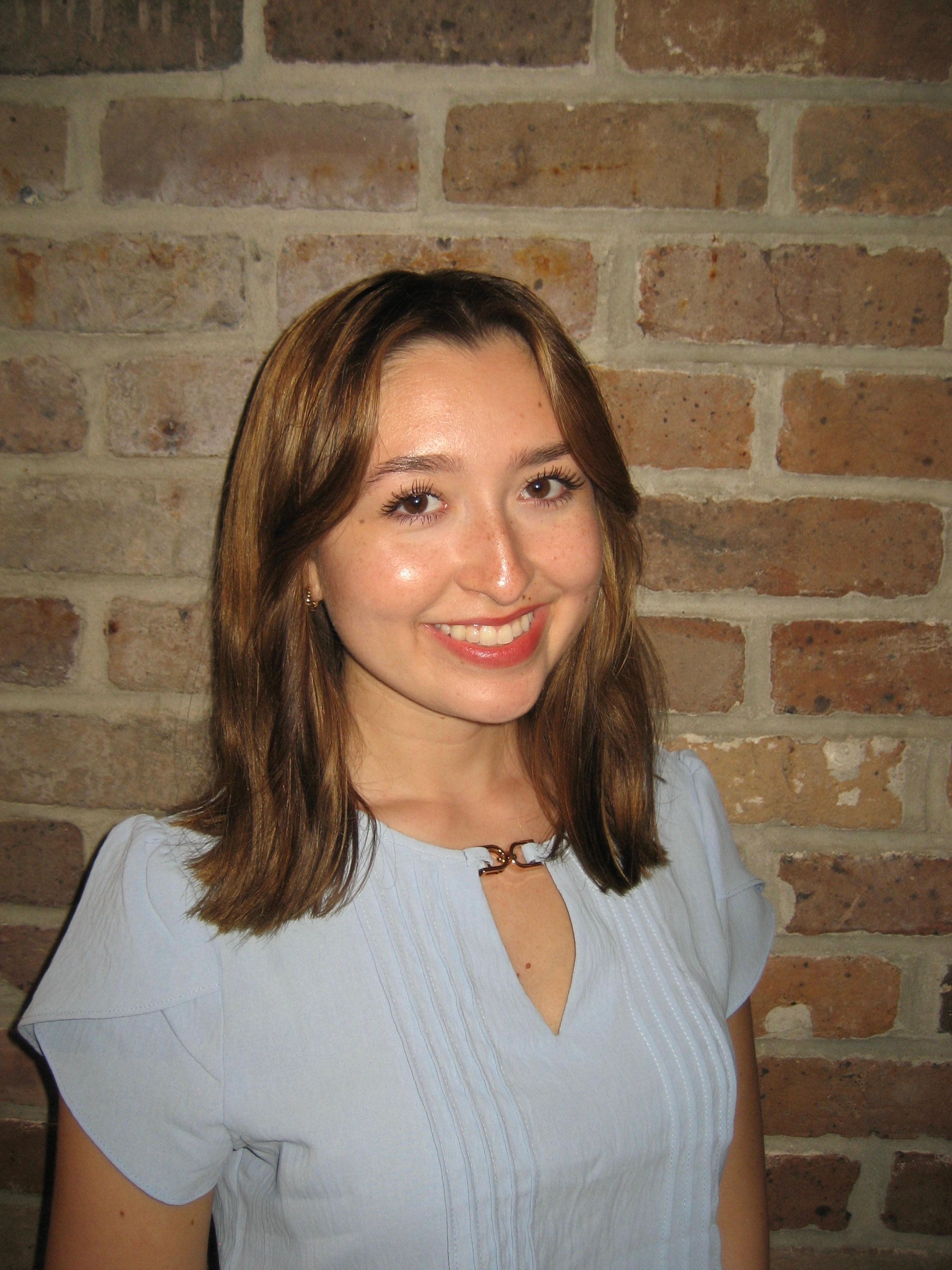
BIO
Hello! My name is Lauren Talley and I am a second year undergraduate student from Coral Springs, Florida. I am pursing a dual-degree in Psychology & Communication Science and Disorders with a minor certificate in Interdepartmental Developmental Disabilities. I am excited about pursuing a career in health care and plan on attending graduate school to become a Speech-Language Pathologist. As a first generation student involved in FSU’s Quest Scholar program, having the opportunity to conduct research through the Hermiller Lab has provided me with fantastic research opportunities that have allowed me to expand my research horizons. In particular, I have familiarized myself with many important aspects of the brain and how stimulation can affect the formation of False memories. In the future, I hope to fuse my knowledge of psychology with my passion for helping those with communication disorders.
False Memories: Investigating The Role Of Transcranial Magnetic Stimulation In Modulating Memory Encoding And Distortion Across Event Boundaries In Supernatural And Crime Narratives Using Naturalistic Stimuli
Authors: Lauren Talley, Marissa MunroeStudent Major: Psychology & Communication Science and Disorders
Mentor: Marissa Munroe
Mentor's Department: Department of Psychology Mentor's College: Arts and Sciences Co-Presenters: Steven Gary
Abstract
False memories are defined as the distortion, in memory, of an event that has previously occurred. False memories impact a range of individuals including eyewitnesses, children, older adults with memory impairment, and individuals with PTSD. The hippocampal-cortical network (HCN) is inclusive of brain regions responsible for memory encoding and retrieval including the angular gyrus, hippocampus, and parietal lobe. Event boundaries occur when there’s a noticeable, or slight change in event scene, time, or context. They play a crucial role in memory formation by activating brain regions responsible for memory consolidation. We aim to investigate how non-invasive brain stimulation (Transcranial Magnetic Stimulation, TMS) mediates false memories, with particular focus on its effects within event boundaries. Our task includes a naturalistic test phase (a video) and a test phase (multiple choice, audio, picture questions). TMS is administered at different time points—before or after the video, before the test, or not at all (behavioral condition)—to determine the optimal stimulation timing for enhancing memory encoding, consolidation, and successful retrieval. We hypothesize that TMS applied to the left parietal site will enhance memory encoding and recall accuracy. Additionally, we predict that TMS will improve recall of details occurring in the middle of event boundaries, counteracting the recency effect, which prioritizes memory retention at the beginning and end of sequences. Results from our study will increase our understanding of how event boundaries reinforce memory consolidation and improve retrieval – additionally we will gain better understanding of how TMS affects memory retrieval for naturalistic stimuli.
Keywords: TMS, false memories, psychology
25th annual Undergraduate Research Symposium, April 1, 2025
Trey Bauldin Poster Session 3: 1:45 pm - 2:45 pm/ Poster #101
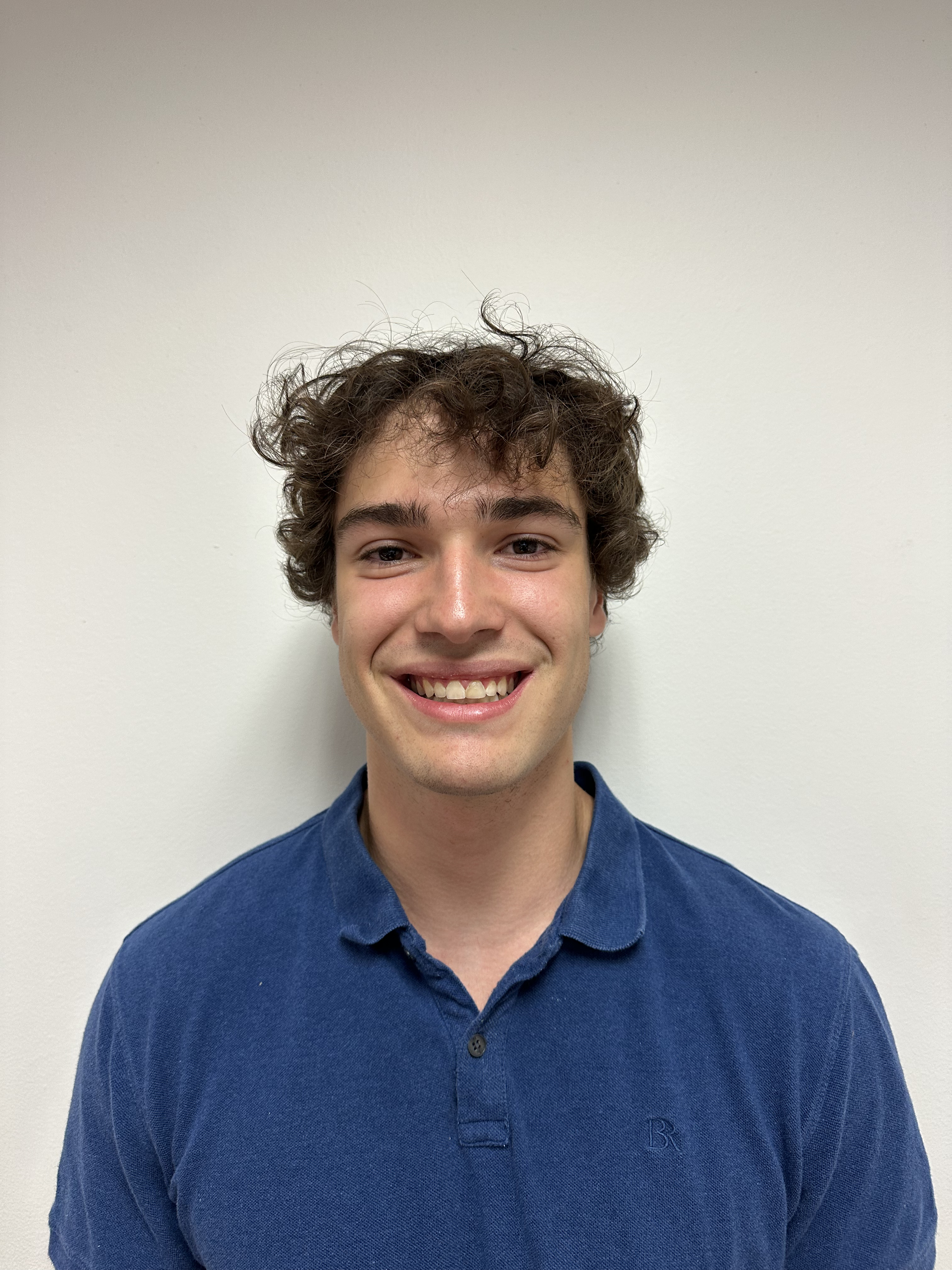
BIO
Hi, my name is Trey Bauldin and I'm a 1st year from Daphne, Alabama. My dream is to attend medical school after I graduate to become an orthopedic surgeon. I'm interested in medical research and research on our natural world.
Wave and Wind Analysis of the Northern Big Bend Region
Authors: Trey Bauldin, Cathrine HancockStudent Major: Biological Sciences
Mentor: Cathrine Hancock
Mentor's Department: Geophysical Fluid Dynamics Institute Mentor's College: Arts and Science Co-Presenters:
Abstract
The northern Big Bend region of Florida is an underresearched, low-wave energy environment. Currently, the majority of research is focused on studying high-wave energy environments, leaving our understanding of low-wave energy environments lacking in comparison. This research seeks to answer the question of how different kinds of wind events affect the wave environment of the region. The was conducted using basic statistical analysis of the wind and wave data collected via buoys at different locations. The analysis was done mainly by comparing how the wind and wave data correlate via graphs in MatLab. The results aren’t fully apparent, but the preliminary results show both local and non-local winds are correlated with max wave heights. Offshore winds produce higher max wave heights than onshore winds do. Furthermore, tropical cyclones produce unusually high wave heights that aren’t typically seen in the Big Bend’s low-wave energy environment. By further understanding these dynamics, the wave environment can be more easily predicted. Further studies can use this research as a basis to research other aspects of the wave environment. These results emphasize the complexity of the wave environment within the region and the many factors at play. This research adds to furthering our understanding of the northern Big Bend region of Florida.
Keywords: Waves Wind Oceanography
25th annual Undergraduate Research Symposium, April 1, 2025
Kassandra Sevila Poster Session 3: 1:45 pm - 2:45 pm/ Poster #158

BIO
I am a first-year student at Florida State University with an immense passion for the environment and its conservation. I’m from the vibrant city of Miami, Florida, where I’m surrounded by the beautiful ocean and just an hour away from the gorgeous Keys and the Everglades. Growing up in such an ecologically rich area has inspired my passion for studying ecology and the ocean, as well as advocating for them. I’m interested in conducting research that focuses on the environment, marine ecosystems, and the environmental factors that impact them. My goal is to contribute to the understanding of these delicate systems and research solutions that promote sustainability and conservation. I plan to pursue graduate school to further my research in the field of environmental science. I’m excited about the opportunity to make a meaningful impact through my work in ecology.
The Future of Bonaire's Coral Reefs
Authors: Kassandra Sevila, Laurel FieldStudent Major: Environmental Science and Psychology
Mentor: Laurel Field
Mentor's Department: Biological Sciences Mentor's College: Arts and Sciences Co-Presenters:
Abstract
Climate change induced coral bleaching threatens coral reefs worldwide, causing mortality, altered species assemblages, and reduced ecosystem services. However, susceptibility to and recovery from coral bleaching varies between coral species and locations. Understanding these dynamics is critical as coral reefs make up only about 1% of the world’s oceans, but house nearly 25% of species found in our oceans. Bonaire, a southern Caribbean island, is dependent on healthy reefs for tourism, food security, and cultural identity. Reef health is impacted by recreation, water quality, coastal development, and temperature stress. We compared the health of coral genera at six different sites in Bonaire in June 2024 - six months after an island-wide coral bleaching event in late 2023. At each site, one 50m transect (15m depth) was photographed to capture the size and health status of coral colonies. We used the program TagLab to analyze 50-60 photos per site, identifying coral colonies to genus or species and assessing their health status. We used the ‘R’ data analysis program to compare coral taxa health and site-level differences. I expect Stephanocoenia Intercepta to be least affected by coral bleaching due to its low bleaching susceptibility and high stress resistance compared to Orbicella spp., Millepora spp., Porites astreoides, Montastrea cavernosa, and Agaricia spp.. A limitation of this study is potential misidentification of coral bleaching versus disease. Our findings will improve the understanding of how coral taxa in the Caribbean respond to coral bleaching events and whether reef resilience varies at small geographic scales.
Keywords: coral reef, Bonaire, climate change, corals, Carribean
25th annual Undergraduate Research Symposium, April 1, 2025
Tvisha Sarkar Poster Session 3: 1:45 pm - 2:45 pm/ Poster #43
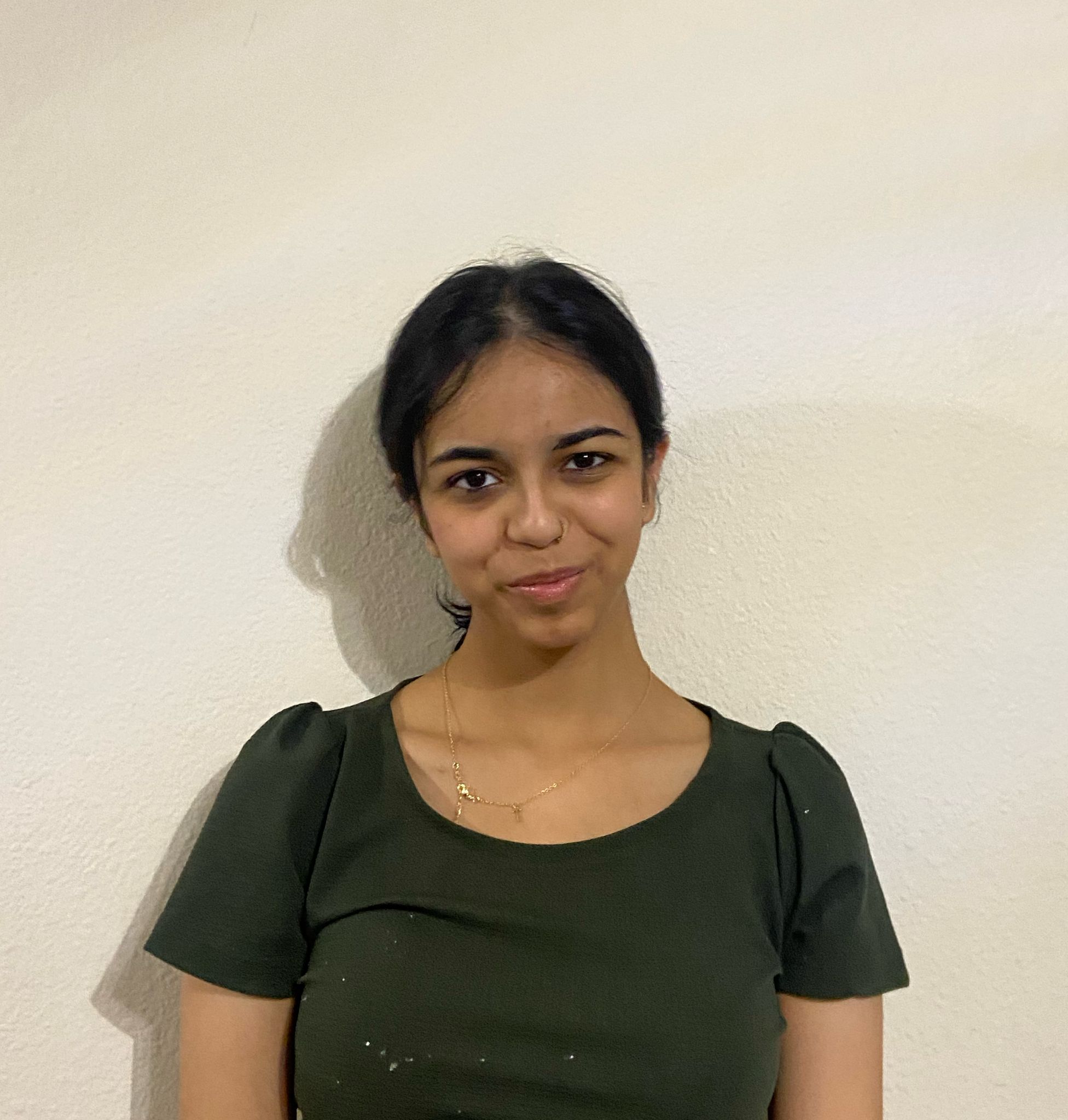
BIO
My name is Tvisha Sarkar and I am a sophmore majoring in Psychology and Statistics. My primary research interests lie in memory recall and cognitive ability, with a growing passion for clinical psychology. I aspire to pursue a Ph.D. in Clinical Psychology, integrating my background in neuroscience research to explore innovative approaches to assessment and treatment.
Specifically, I am interested in the potential applications of transcranial magnetic stimulation (TMS) in clinical evaluations and therapeutic interventions. My experience in neuroscience labs has deepened my curiosity about how neuromodulation techniques can enhance diagnostic accuracy and improve treatment outcomes for psychological disorders. Additionally, I have a strong affinity for data analysis and its role in psychological research, as it allows for objective insights into cognitive and behavioral patterns.
In the long term, I aim to balance both clinical practice and research, working as a therapist while contributing to advancements in psychological science. I am particularly motivated to bridge the gap between data-driven research and practical therapeutic approaches, ensuring that innovative methodologies, such as TMS, are effectively integrated into clinical psychology.
Fixation & Forgetting: How Trauma Affects Memory Encoding
Authors: Tvisha Sarkar, Molly Hermiller PhDStudent Major: Psychology and Statistics
Mentor: Molly Hermiller PhD
Mentor's Department: Psychology and Neuroscience Mentor's College: Arts and Science Co-Presenters: Bronson Empsall
Abstract
This study examines how hypervigilant symptoms affect visual fixation on naturalistic
narratives and its correlation with memory encoding and recall. Although previous
research has shown the relationship between hypervigilance and increased fixation
points, it has not looked at naturalistic narratives that have positive or
negative outcomes or the relationship to memory encoding. Participants will fill
out self-report measures alongside a structured clinical interview. They will then perform a cognitive task that involves viewing a series of landscape images and rating them on a Likert scale while an eye-tracker records their eye movements. The next phase will prime them for hypervigilant behavior while encoding narratives with positive or negative conclusions over landscape images. They will complete a round of self-reports and then complete the final phase where participants are asked to reimagine and visually retrace images where they believe they belonged on screen. It is expected that participants with higher hypervigilance scores will remember the placement of negative resolutions better than others. They will also remember less and have more overall fixation points across the landscapes than their counterparts. The results could suggest that hypervigilance not only has an attention bias towards threatening stimuli, but a memory bias and general memory deficits. It would also fall in line with a dual process model of attention for PTSD, that deficits in top-down attention will lead to a larger focus on negative stimuli and the facilitation of threat detection, but deficits in bottom-up attention could lead to general distractibility from the task.
Keywords: PTSD, Eye tracking, Memory, Hyppervillagance
25th annual Undergraduate Research Symposium, April 1, 2025
Iris Bui Poster Session 2: 10:45 am - 11:45 am/ Poster #260

BIO
My name is Iris Bui, I am from Spring Hill, Florida, and I am a sophomore majoring in Management Information Systems and Finance with a minor in Data Analytics. Aside from UROP, I am a member of the FSU Equestrian Hunt Seat Team and a Barista at the FSU Student Union Starbucks. Outside of class and extracurriculars , I spend my free time reading, spending time with my family and friends, enjoying the outdoors, and baking. In the future, I hope to have the opportunity to continue to work on similar projects involving data analytics.
United States Housing Choice Voucher Gap
Authors: Iris Bui, Shane DabneyStudent Major: Management Information Systems and Finance
Mentor: Shane Dabney
Mentor's Department: DeVoe Moore Center Mentor's College: Florida State University Co-Presenters: Mira Scannapieco
Abstract
The Housing Choice Voucher (HCV) program is a government funded program designed to assist low-income families in affording safe and decent housing in the private market. However, despite many qualifying individuals, only a small number of people receive vouchers. The difference in the number of available housing choice vouchers and the number of households who qualify for these vouchers has previously been believed to be one in four, meaning one in four qualifying households will receive a voucher. Using data collected from the Housing and Urban Development (HUD) database, which provides data on previous HCV recipients, as well as US Census data, this investigation has been able to estimate the number of qualified households more accurately and, as a result, more accurately estimate the HCV gap. Using a Python code, trends both within states and across different regions have been identified, allowing for a better understanding of the distribution of HCVs across the United States. We plan to take these findings and further our research, analyzing the demographic breakdown of qualifying households and voucher recipients as well as eventually integrate the number and demographic characteristics of the households applying for the HCV program to fully understand this gap, its causes, and its potential implications for low-income families.
Keywords: Housing Choice Voucher Program, Housing Affordability, Economics, Public Policy
25th annual Undergraduate Research Symposium, April 1, 2025
Alexander de Gale Poster Session 2: 10:45 am - 11:45 am/ Poster #8
BIO
I am a sophomore cell and molecular neuroscience student from Allentown, Pennsylvania passionate about conducting scientific research which I've gotten the opportunity to do through UROP. I am pursuing a career in the medical field where I can apply my curiosity in my work.
Determining Behavioral Sex Differences to Chronic Sleep Deprivation in Mice
Authors: Alexander de Gale, Dr. Lisa LyonsStudent Major: Cell and Molecular Neuroscience
Mentor: Dr. Lisa Lyons
Mentor's Department: Program in Neuroscience Mentor's College: College of Arts and Sciences Co-Presenters: Collette Connell
Abstract
Over one-third of Americans suffer from chronic sleep deprivation in today’s society because of high work demands and added daily stress. Chronic sleep loss can lead to many health and neurodegenerative issues such as anxiety, depression, memory loss, and even Alzheimer's. This project studies the difference between male and female behavioral responses to a later bedtime using physical cues. To conduct this experiment, male and female mice were sleep deprived 5 hours a day, for 5 days to mimic a strenuous work week with hours extending past typical sleep onset. A protocol of manually tapping and shaking the cages when the mice first started to fall asleep was used and tallies of each tap and shake were recorded. This data was then plotted and analyzed in GraphPad Prism. The results show that the female mice required significantly fewer taps and shakes on average compared to the males suggesting they were more active. Future experiments could study the implications of possible neuroprotective factors through RNA sequencing and gene expression analysis. Analyzing the over or underexpression of certain genes, as well as hormonal fluctuations in females during sleep deprivation could provide insight on a possible neuroprotective effect.
Keywords: Neuroscience, Sleep, Sleep Deprivation
25th annual Undergraduate Research Symposium, April 1, 2025
Hefina Oliver Poster Session 1: 9:30 am - 10:30 am/ Poster #85
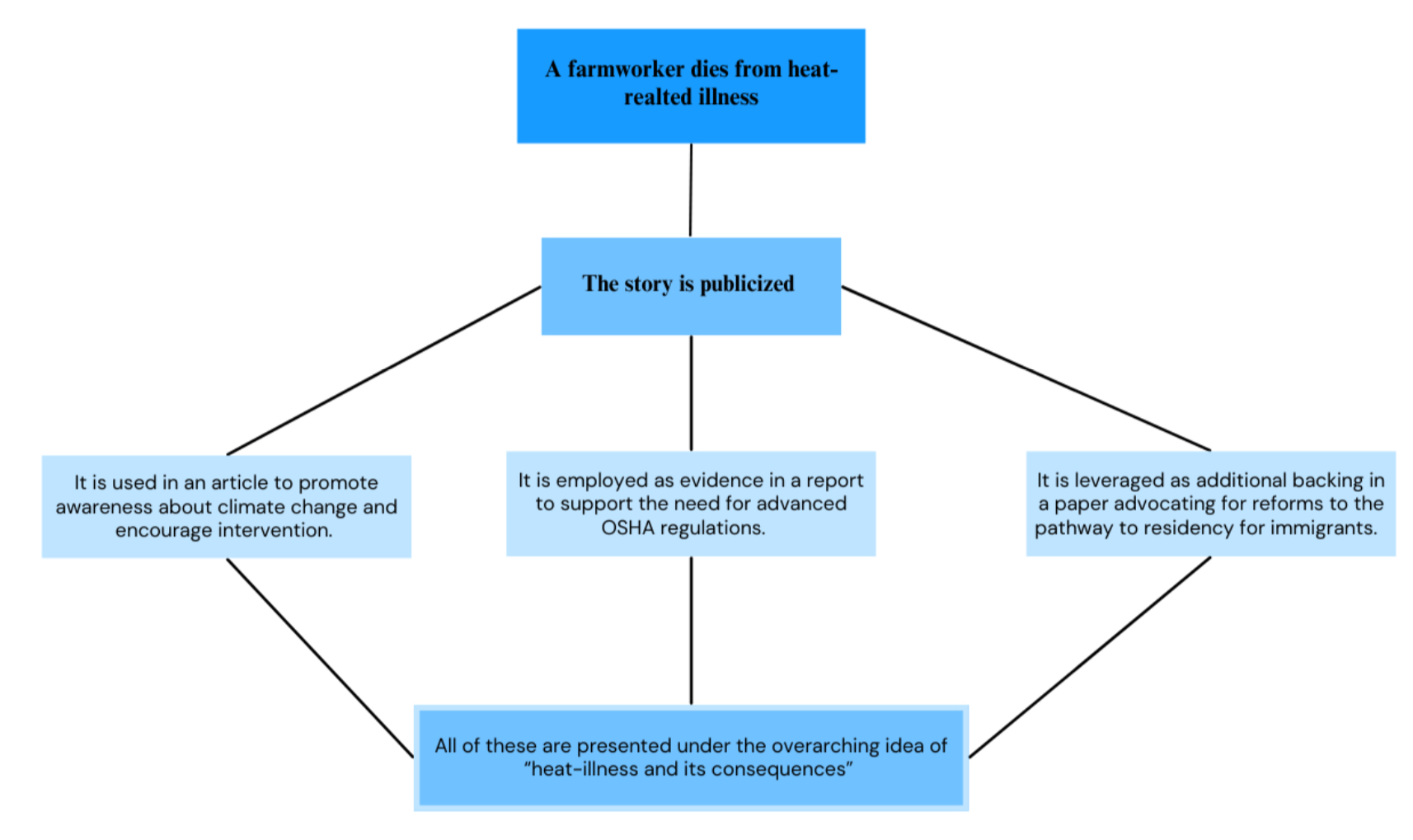
BIO
My name is Hefina Oliver and I am a second-year student at Florida State University. I will be starting FSU’s nursing program in Fall 2025 and plan to pursue a Doctor of Nursing Practice degree after earning my BSN and gaining work experience. I have a strong interest in medical research and innovation and hope to contribute to advancements in patient care. I would also like to study the influence of immigration status on access to healthcare and clinical outcomes. My current project examines how heat-related illness in farmworkers (many of whom are foreign born) is presented in the media and the narratives that shape public perception.
The Politics of Heat: How Farmworker Heat Illness is Framed in Public Discourse
Authors: Hefina Oliver, Mikayla HeathStudent Major: Nursing
Mentor: Mikayla Heath
Mentor's Department: Department of Human Development and Family Sciences Mentor's College: College of Heath and Human Sciences Co-Presenters: Samantha Mejia
Abstract
Farmworkers, particularly those from immigrant backgrounds, face disproportionately high risks of heat-related illness and fatalities due to extreme working conditions, climate change, and insufficient workplace protections. Despite these risks, public narratives often deflect responsibility from systemic failures by attributing blame to the workers themselves, ultimately shaping policy decisions and public perception. This study employs a systematic content analysis of media discourse from 2017 to 2022, analyzing a sample of news articles and blogs to identify recurring themes and framing strategies. By categorizing specific language and topics, the study examines how heat-related illness is represented in media reports and its implications for policy advocacy. Findings reveal that no singular entity is consistently held accountable for these illnesses, and the issue is frequently leveraged to discuss broader issues such as climate change, labor rights, and immigration policy. The variability in framing underscores the complexity of factors contributing to farmworker heat illness and mortality. This research highlights the need for stronger legislative protections and a shift in public discourse toward systemic accountability.
Keywords: Heat-illness, farmworkers, climate
25th annual Undergraduate Research Symposium, April 1, 2025
Nashely Gabriel Cardenas Poster Session 2: 10:45 am - 11:45 am/ Poster #96
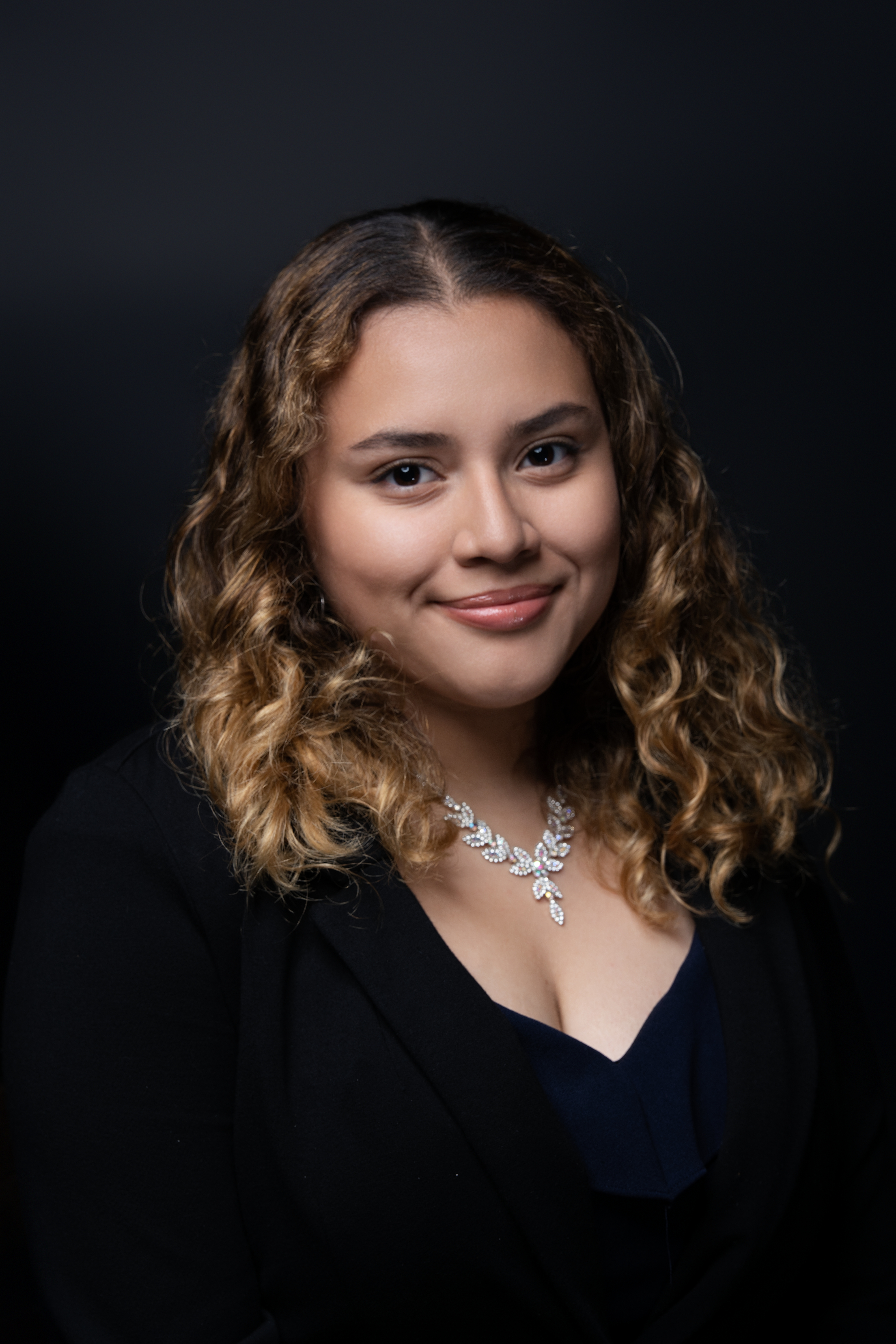
BIO
Nice to meet you! My name is Nashely Gabriel Cardenas, an undergraduate student at Florida State University pursuing a bachelor in Accounting with a minor in Criminology. My graduation journey has been accelerated through Degree in Three with hopes of entering the workforce and getting my CPA licensure. My passions include uncovering financial irregularities, preventing fraud, and maintaining financial integrity within different fields. I am currently involved with the Undergraduate Research Opportunity Program where I learned the importance of organization, problem-solving, and field work. Other organizations I take proud of being a member of are Women in Accounting, Unconquered Scholars, and a dance team Next Level Noles. I'm always eager to network with professionals with hands-on experience in fraud outreach, litigation assistance, and forensic accounting.
A Mixed-Methods Evaluation of the Impacts and Implementation of Florida's Risk Protection Order (RPO) Law
Authors: Nashely Gabriel Cardenas, Dr. Emma FridelStudent Major: Accounting
Mentor: Dr. Emma Fridel
Mentor's Department: College of Criminology & Criminal Justice Mentor's College: College of Criminology & Criminal Justice Co-Presenters: Francisca Puiatti, Tatiana Giraldo, Andronika Christian, Olivia Jaillet
Abstract
The goal of this project is to explore the efficacy and implementation of Risk Protection Orders (RPOs) in Florida.
RPOs were introduced in the Florida Legislature in 2018 and since their inception very few studies have been conducted on them. It is important that we investigate the implementation of RPOs on a larger scale to determine whether they are an efficient mechanism to reduce gun violence. The three stages to this analysis are: collecting the data from over 15,000 RPO cases from Florida to create a database, running four levels of quantitative analysis to evaluate the effect of RPOs on reducing gun violence and using mixed methods to explore the differences in RPO implementation across jurisdictions. Although the project is in its first stages, it promises to strengthen and broaden the knowledge on RPOs and their relation to gun violence exponentially. The database created will be the largest and most representative sample of RPOs and will allow for the most comprehensive evaluation of a state's RPO laws. The findings generated by the analyses will reveal important trends of the implementation and efficiency of RPOs in preventing gun violence, an ongoing issue that has affected millions of lives. Researching the efficacy of the legislation that is created to reduce gun violence will allow future legislators to create new and better solutions.
Keywords: RPO Laws, Criminology, Firearms
25th annual Undergraduate Research Symposium, April 1, 2025
Raphaela De Faria Aildasani Poster Session 1: 9:30 am - 10:30 am/ Poster #219

BIO
I am a Florida State University student majoring in Biomedical Sciences. Passionate about medicine and patient care, I aspire to become an anesthesiologist. I am dedicated to build a strong foundation in health sciences and work hard towards my goal of attending medical school.
Enhancing Literacy Through Morphological Awareness: The MAP-R Intervention for Diverse Learners
Authors: Raphaela De Faria Aildasani , Carla WoodStudent Major: Interdisciplinary Medical Sciences
Mentor: Carla Wood
Mentor's Department: College of Communication and Information Mentor's College: College of Communication and Information at Florida State University Co-Presenters:
Abstract
Morphological awareness plays a crucial role in language and literacy development, particularly for students with disabilities, multilingual learners, and those who are d/Deaf or hard of hearing (D/HH). The Morphological Analysis Pathway to Reading (MAP-R) project is a computer-delivered intervention designed to enhance morphological knowledge, academic vocabulary, and reading comprehension through an interactive e-learning platform. This study investigates the effectiveness of MAP-R in improving students’ literacy outcomes by providing explicit morphological instruction, direct vocabulary teaching, and on-demand Spanish and sign language support.
The intervention, implemented three days per week for 15-20 minutes, engages third and fourth-grade students in structured activities that reinforce word structure and meaning. Writing samples are collected and analyzed using MorphoLex, a writing sample analysis tool that assesses the complexity of words, including base words, inflections, and derivational morphemes. Additionally, pre- and post-intervention language assessments and embedded weekly quizzes track individual student progress over the 16-week study period.
In our findings we hope to see a significant improvement in morphological awareness, vocabulary acquisition, and reading comprehension, with students demonstrating increased use of base words and morphemes in writing tasks. These results would suggest that MAP-R is an effective tool for enhancing literacy skills in diverse student populations. Future research will explore the long-term impact of the intervention and potential adaptations for broader educational settings.
Keywords: morpholex, child language development, literacy intervention
25th annual Undergraduate Research Symposium, April 1, 2025
Piper Bourne Poster Session 1: 9:30 am - 10:30 am/ Poster #199

BIO
Piper Bourne is a freshman majoring in Physics and a member of the Honors Program at Florida State University. She is actively involved in the Society of Physics Students and is currently engaged in research related to condensed matter physics. Her academic interests lie in exploring the principles of physics through both coursework and hands-on research.
Growth and Characterization of PrBiTe Crystals
Authors: Piper Bourne, Shyam Raj KarullithodiStudent Major: Physics
Mentor: Shyam Raj Karullithodi
Mentor's Department: Department of Physics Mentor's College: College of Arts and Sciences Co-Presenters:
Abstract
A major problem in modern technology is the volume of transistors and computers chips that are currently being used, more specifically the wires in these devices. Alternatives to the current wires are high-mobility materials. High-mobility materials can be used for many applications in these devices by utilizing their low resistivity and small Joule heating. A known type of high-mobility material is Dirac materials, whose band dispersion is linear in contrast to a quadratic dispersion in normal materials. In this project, we grew a new Dirac material PrBiTe, whose linear band dispersion is confirmed by the band structure calculation. The crystalline structure and stoichiometric composition were investigated via X-ray diffraction and energy dispersive X-ray spectroscopy, indicating high crystallinity and precise stoichiometry. Preliminary transport measurements reveal linear magnetoresistivity, and seemingly the coexistence between light and heavier electrons confirming the Dirac nature of the compound. The resistivity measured at T = 300 K shows a low value of 10.25 mΩ cm, which could indeed be useful as a low resistivity material for interconnects.
Keywords: Physics, Dirac Materials, Condensed Matter
25th annual Undergraduate Research Symposium, April 1, 2025
Dara Dereje Poster Session 4: 3:00 pm - 4:00 pm/ Poster #62
BIO
Hailing from Orlando, Florida, Dara Dereje is a sophomore at Florida State University with a passion for both the humanities and medicine. Combining her love for history with academia, she has chosen to focus this specific project on the former. Other than being involved in UROP, she is also an active member of the African Student Association and is going into her second year as an Exploratory Peer Advising Leader, where she supports fellow students in navigating their academic journeys. With two years remaining at Florida State, she is eager further expand her campus involvement and professional development.
The Man, The Myth, The Legend: Diego Corrientes and the History of Spanish Banditry
Authors: Dara Dereje, Benjamin DoddsStudent Major: Humanities on Pre-Physician Assistant Track
Mentor: Benjamin Dodds
Mentor's Department: History Mentor's College: College of Arts and Sciences Co-Presenters:
Abstract
The idea of banditry is not a new one especially in Spanish history. Throughout decades stories have been told both orally and in writing about sly tricksters and bandits and women falling in love. One of the most famous bandits, Diego Corrientes, has lived a life that has been iconic within Spanish history. The role he has played is a testament not only to the Spanish culture and the time, but the way historical stories have evolved. To research him, I used literature and media that told the story of his life – both fiction and non-fiction to gain a better understanding of who he was and became. Research that I have done has showed that much of what is written about the bandit has evolved through myth. There is not a lot on his actual life, rather an idea of a person that has contributed to a larger literary culture. Much of what I found shows that the Spanish took a small idea of a historical bandit and used it to further an entire genre based on bandits, eventually evolving into songs, movies, and love stories. This idea is part of a larger literary culture that spans even outside of Spain that values stories with a “Robin Hood” type character – like Corrientes himself.
Keywords: History, Spanish, Bandits, Myth
25th annual Undergraduate Research Symposium, April 1, 2025
Jalliyia Phillippy Poster Session 1: 9:30 am - 10:30 am / Poster #205

BIO
My name is Jalliyia, and I’m a sophomore majoring in Public Health from Broward County, Florida. I have a deep interest in health and medicine, with a particular focus on understanding how disparities in healthcare affect minority populations. I’m passionate about finding solutions to improve healthcare access and outcomes, especially for underserved communities. I also aim to contribute to the advancement of medical practices through innovative treatments, technologies, and healthcare policies. My ultimate career goal is to become a doctor, where I can apply my knowledge to improve patient care and outcomes in the medical field.
Examining the Effects of Children’s Word Specific Phonological Awareness on Word Reading Accuracy within a Lexical Quality Theoretical Framework
Authors: Jalliyia Phillippy, Dr. Nancy C. MarencinStudent Major: Public Health
Mentor: Dr. Nancy C. Marencin
Mentor's Department: Florida Center for Reading Research & Psychology Mentor's College: College of Arts and Sciences Co-Presenters: Maya Leshnov, Ziraili Contreras, Bailey Apgar, Ruhee Patel
Abstract
Purpose
Although the significant relation between phonological awareness and word reading is well documented, questions remain about the nature of this relationship over time. This is particularly important given that the development of lexical representations is item-based and depends on the unique interaction between the skills a child brings to the task and item/word characteristics. This study integrates a word specific measure of PA to further clarify the relationship between the quality of an individual’s phonological representations and word reading accuracy.
Method
Second-grade (n=80) and first-grade students (data collection in progress) attending Title-I schools in the southeast United States completed the Phonological Awareness Screening Test (PAST; Kilpatrick, 2021) and read the same 52 words. Children also completed other child-level, word-level and child-by-word level measures of reading and reading related skills.
Results
Preliminary results from logistic cross classified random-effects models using our sample of second-grade students indicated significant child-level (decoding and vocabulary) and word-level (spelling-to-pronunciation transparency rating, frequency, and phoneme length) predictors of word reading accuracy. At the child-by-word level, a child’s word specific PA, letter-sound knowledge, and familiarity were not significant predictors.
Conclusions
Initial results suggest these second-grade students have redundant orthographic, phonological, and semantic representations of the words in our study. Redundancy can facilitate word recognition in the absence of complete and precise word knowledge (Adlof et al., 2016). The lack of significant child-by-word effects in our models may represent the important role redundancy played in their word reading accuracy and the potential consequences of lexical quality (Perfetti, 2007).
Keywords: Phonological awareness, word reading, decoding
25th annual Undergraduate Research Symposium, April 1, 2025
Longjie (Jack) Zhao Poster Session 3: 1:45 pm - 2:45 pm / Poster #217

BIO
Hello! My name is Jack, and I’m a sophomore at Florida State University majoring in Biomedical Sciences. I’m originally from Melbourne, Florida, and I’m passionate about exploring how biological systems function and how they can be targeted to treat disease. My research interests lie in molecular biology, neurology, and metabolism, particularly how environmental factors like nutrition can influence gene expression and contribute to chronic illness. I hope to attend medical school and eventually pursue a career as a physician, combining clinical practice with research to help improve patient outcomes.
Post-transcriptional regulation of hepatic lipid metabolism by Y-box binding protein
Authors: Longjie (Jack) Zhao, Dr. James JordanStudent Major: IMS - Clinical Professions
Mentor: Dr. James Jordan
Mentor's Department: Department of Biology Mentor's College: College of Arts and Sciences Co-Presenters: Mia Harrell, Paulos Samuel, Rebekah Winborn
Abstract
Metabolic dysfunction‐associated steatotic liver disease (MASLD) is a growing global health challenge characterized by excessive hepatic lipid accumulation in the setting of obesity and insulin resistance. Current therapies remain limited, underscoring the need to identify molecular drivers of disease progression. Y‐box binding protein-1 (Ybx1) is a single‐stranded nucleic acid binding protein implicated in MASLD in diet‐induced obesity (Jordan et al., bioRxiv, 2024), yet its role in hepatic lipid metabolism remains unclear. We performed an integrated multi‐omic analysis and identified ten genes bound by Ybx1 that displayed altered mRNA and protein expression. We hypothesized that these genes contribute to lipid accumulation in hepatocytes. To test this, we knocked down eight of these genes in hepatocyte‐like Huh7 cells using siRNA. Cells were then exposed to 0.25 mM oleic and palmitic acid for 16 hours to mimic a high‐fat diet, stained with Oil Red O, and analyzed using ImageJ. Lipid content was quantified by extracting Oil Red O from intracellular droplets and measuring absorbance at 492 nm. Preliminary results indicate that among seven genes with transcripts stabilized by Ybx1, siRNA against three—Carnitine O-Acetyltransferase (CRAT), Vanin 1 (Vnn1), and Abhydrolase domain containing 2 (Abhd2)—reduced lipid accumulation. In contrast, knockdown of Carboxylesterase 3 (Ces3), a gene negatively regulated by Ybx1, increased lipid storage. These findings reveal a dual regulatory role for Ybx1 in hepatic lipid metabolism and identify potential targets for MASLD therapy. Future work will validate these targets using overexpression, confirm Ybx1:mRNA interactions by ChIP‐qPCR, and test Ybx1’s role in mRNA stability with RT-qPCR.
Keywords: Liver Metabolism, Molecular Biology, Obesity, Diet, Liver Disease
25th annual Undergraduate Research Symposium, April 1, 2025
Maria Lima Sandim Poster Session 1: 9:30 am - 10:30 am / Poster #43
BIO
I am an undergraduate student passionate about medicine, research, and community service. Currently pursuing a pre-med track, I’ve had the chance to obtain hands-on experience through hospital internships, shadowing physicians, and participating in research focused on dyslexia and Alzheimer’s disease. As a member of the Undergraduate Research Opportunity Program, I’ve developed strong skills in data analysis, academic writing, and collaboration. Outside of my coursework, I worked as a Learning Assistant for trigonometry, where I supported students in building confidence and understanding. I’m also involved in a Directed Individual Study project that focuses on helping Latino professionals in music therapy navigate the U.S. licensure process—combining my interests in healthcare and advocacy.
Predicting Alzheimer's: A Cognitive Skills Approach to Early Detection
Authors: Maria Lima Sandim, Dorota Kossowska-KuhnStudent Major: Biological Sciences
Mentor: Dorota Kossowska-Kuhn
Mentor's Department: Psychology, Arts and Sciences Mentor's College: Psychology, Arts and Sciences Co-Presenters: Aaliyah Daflaar
Abstract
The prevalence of dementia, especially Alzheimer's disease (AD), is predicted to increase as the
world's population ages, making early and precise diagnosis more important than ever. Our study
compares the efficacy of spatial navigation tests with other diagnostic predictors and examines their
predictive value in detecting mild cognitive impairment (MCI), a precursor to AD. By knowing
which markers independently influence the prediction of AD, early detection techniques can be
improved, which will ultimately improve patient care and the results of interventions. This study
investigates the possibility that deficiencies in spatial navigation could serve as an early indicator of
mild cognitive impairment (MCI) and its development into Alzheimer's disease. Spatial navigation
tests presents a promising tool for early detection because of the hippocampus's function in
navigation and its influence in early AD. We carried out a meta-analysis to measure the disparities in
spatial navigation abilities between older adults with MCI and those in good cognitive health. Our
results supported the diagnostic potential of spatial navigation tests with a significant standardized
mean difference. Future model-based meta-analyses that compare spatial navigation with other
predictors and determine their separate contributions to the diagnosis and progression of AD are
made possible by these findings. Finding reliable early predictors, such as spatial navigation test
results, can improve patient outcomes through permitting the earlier incorporation of support and
treatment plans, increase diagnostic accuracy, and enable prompt interventions.
Keywords: Alzheimer's, Dementia, Memory, Spacial Navigation
25th annual Undergraduate Research Symposium, April 1, 2025
Emily Fleurinor Poster Session 4: 3:00 pm - 4:00 pm/ Poster #238

BIO
Emily is a pre-law student from Broward County, Florida, majoring in real estate with a minor in law and philosophy. She has a strong interest in both criminal and property law, and her research in criminology reflects her passion for understanding the legal system and its impact on society. As a first-generation college student, she understands the importance of advocating for those who are often overlooked. Her work focuses on issues related to justice, housing, and social inequality, and she hopes to use her research to spark conversations that lead to real change. Outside of academics, she has served as an orientation leader and held leadership roles in student government, which have helped her develop strong communication and advocacy skills. She is committed to using her knowledge and experiences to challenge injustices, support marginalized communities, and create a lasting impact in the legal field.
Misdemeanor (In)Justice
Authors: Emily Fleurinor, Jennfier CoppStudent Major: Real Estate
Mentor: Jennfier Copp
Mentor's Department: Director, Jail Research & Policy Institute Mentor's College: Criminology Co-Presenters: Phoenix Ricketts, Alexa Athanassie, Victoria Baran, Rachel Douglas, Marina Farulla, Hannah Gibb, Khalia Hasboun
Abstract
It is estimated that over 13 million misdemeanor cases are filed in the United States each year. Recent research has highlighted some of the concerns related to the misdemeanor system of justice in the United States, including violations of due process and practices that contribute to inequities. The current research intends to explore the misdemeanor system in Florida's Second Judicial Circuit to understand the extent to which misdemeanor courtrooms are complying with the law and to understand some of the factors associated with non-compliance and other potential sources of unfairness. To accomplish this, a team of undergraduate student researchers conducted systematic courtroom observations using a custom form across the circuit, comprised of six separate courtrooms. Observations included misdemeanor court arraignments and criminal traffic proceedings. Courtroom observations were completed in both rural and urban settings. Drawing on the data elicited during courtroom observations, future analyses will systematically explore local courtroom practices to capture the extent of legal compliance and to identify factors associated with non-compliance in legal proceedings. Our findings will be shared with local stakeholders to inform discussions of the misdemeanor system of justice, including ways to promote best practices.
Keywords: criminal justice, due process, courts, mixed methods research form
25th annual Undergraduate Research Symposium, April 1, 2025
Bronson Empsall Poster Session 3: 1:45 pm - 2:45 pm/ Poster #43
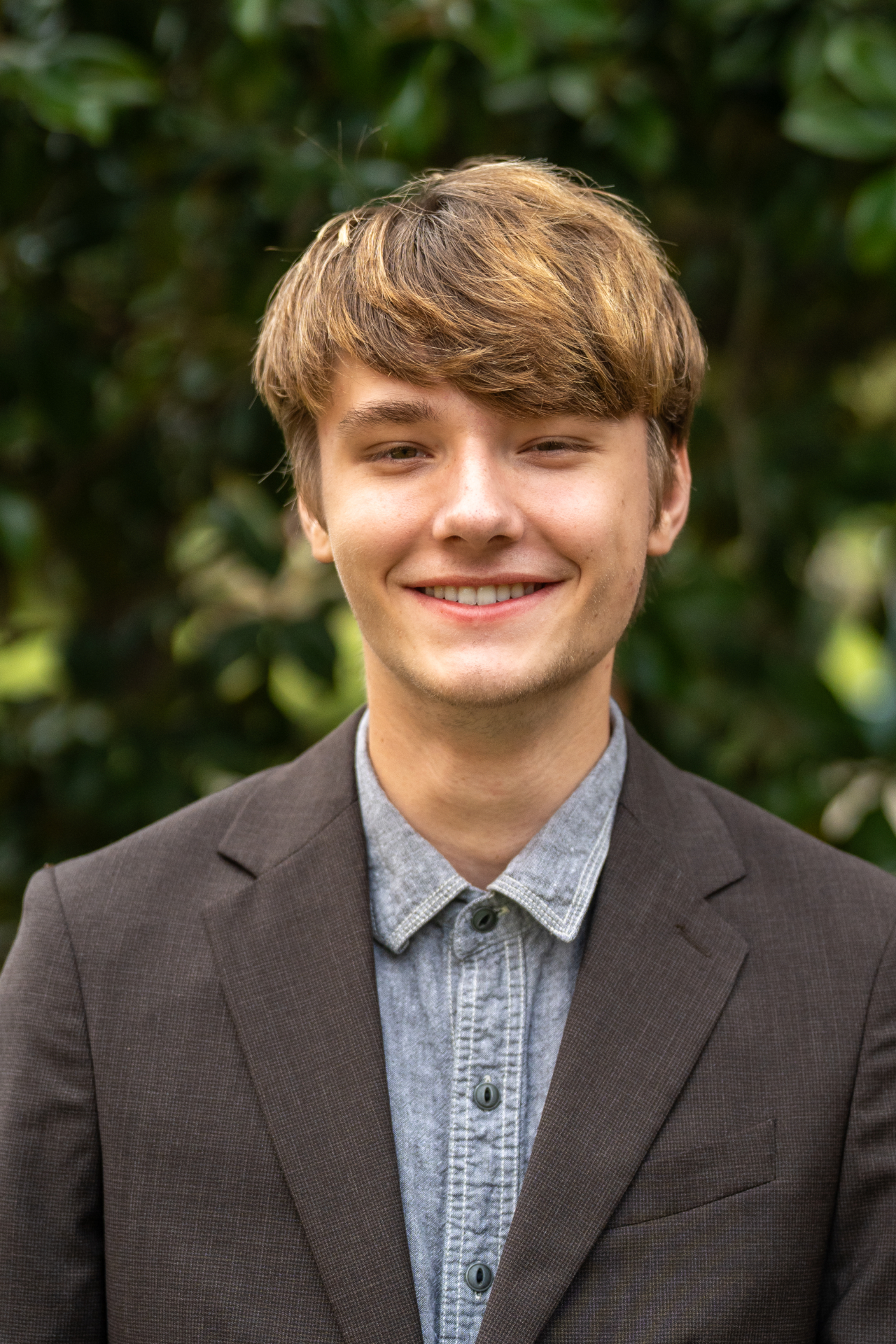
BIO
Greetings from this wrinkled cortex that calls itself Bronson! I'm a sophomore who loves learning about neuroscience. As someone with ADHD, I’m fascinated by the complex workings of memory—especially when it seems to elude me. I began my interest in trauma by managing the social media for SRQ Strong, a non-profit focused on creating trauma-informed community education close to my hometown. Working in the Hermiller lab, I've had the opportunity to study how it crosses over with memory formation and dive into literature on the brain. I'd love to keep exploring the brain further through a clinical lens and advocate for the neurodivergent movement. Beyond research, I'm the outreach coordinator for the NeuroUnity Alliance Society, the only neurodivergent club on campus. I’m also the founder and president of The PIT Metal & Punk Club, the music that powered the long hours spent working on this poster!
Fixation & Forgetting: How Trauma Affects Memory Encoding
Authors: Bronson Empsall, Molly S. Hermiller, PhDStudent Major: Behavioral Neuroscience
Mentor: Molly S. Hermiller, PhD
Mentor's Department: Psychology Mentor's College: Northwestern University Co-Presenters: Tvisha Sarkar
Abstract
This study examines how hypervigilant symptoms affect visual fixation on naturalistic
narratives and its correlation with memory encoding and recall. Although previous
research has shown the relationship between hypervigilance and increased fixation
points, it has not looked at naturalistic narratives that have positive or
negative outcomes or the relationship to memory encoding. Participants will fill
out self-report measures alongside a structured clinical interview. They will then perform a cognitive task that involves viewing a series of landscape images and rating them on a Likert scale while an eye-tracker records their eye movements. The next phase will prime them for hypervigilant behavior while encoding narratives with positive or negative conclusions over landscape images. They will complete a round of self-reports and then complete the final phase where participants are asked to reimagine and visually retrace images where they believe they belonged on screen. It is expected that participants with higher hypervigilance scores will remember the placement of negative resolutions better than others. They will also remember less and have more overall fixation points across the landscapes than their counterparts. The results could suggest that hypervigilance not only has an attention bias towards threatening stimuli, but a memory bias and general memory deficits. It would also fall in line with a dual process model of attention for PTSD, that deficits in top-down attention will lead to a larger focus on negative stimuli and the facilitation of threat detection, but deficits in bottom-up attention could lead to general distractibility from the task.
Keywords: PTSD, memory, eyetracking, hypervigilance, trauma
25th annual Undergraduate Research Symposium, April 1, 2025
Braden Skaggs Poster Session 2: 10:45 am - 11:45 am/ Poster #68

BIO
I am a sophomore student from Lithia, FL, who is currently majoring in Interdisciplinary Medical Sciences - Clinical Professions at Florida State University. I am on a pre-medical track, with aspirations of practicing in either pediatrics or family medicine. I am also a member of both the Honors Program and the Honors Medical Scholars (HMS) Program. During my time at FSU, I have engaged in a wide range of activities, including tutoring migrant children in Quincy, FL, and volunteering with the CCAV program at Tallahassee Memorial HealthCare.
Can ChatGPT Diagnose Psychopathology? Developing a Chatbot to Assess for Alcohol Use Disorder
Authors: Braden Skaggs, Michael IriasStudent Major: Interdisciplinary Medical Sciences (IMS) – Clinical Professions
Mentor: Michael Irias
Mentor's Department: Psychology Mentor's College: Psychology Co-Presenters:
Abstract
This study aims to develop a prototype AI chatbot capable of conducting diagnostic interviews based on the Structured Clinical Interview for DSM (SCID). By leveraging artificial intelligence, this research explores the potential of AI-driven diagnostic tools to improve accessibility and efficiency in mental health assessments. The chatbot is designed to simulate clinical interviews by asking structured SCID-based questions, with an initial focus on diagnosing alcohol use disorder within the past 12 months and classifying severity as mild, moderate, or severe. Its performance will be evaluated based on diagnostic accuracy, alignment with clinical assessments, and user interaction quality. Future iterations will expand its diagnostic scope to additional mental health conditions. The expected outcome is a functional AI prototype demonstrating the feasibility of AI-assisted diagnostic tools in mental health screening. This research highlights the potential of AI to supplement traditional diagnostic methods, facilitating early intervention and expanding access to mental health care.
Keywords: artificial intelligence, psychology, mental health
25th annual Undergraduate Research Symposium, April 1, 2025
Bailey Underwood Poster Session 4: 3:00 pm - 4:00 pm/ Poster #40
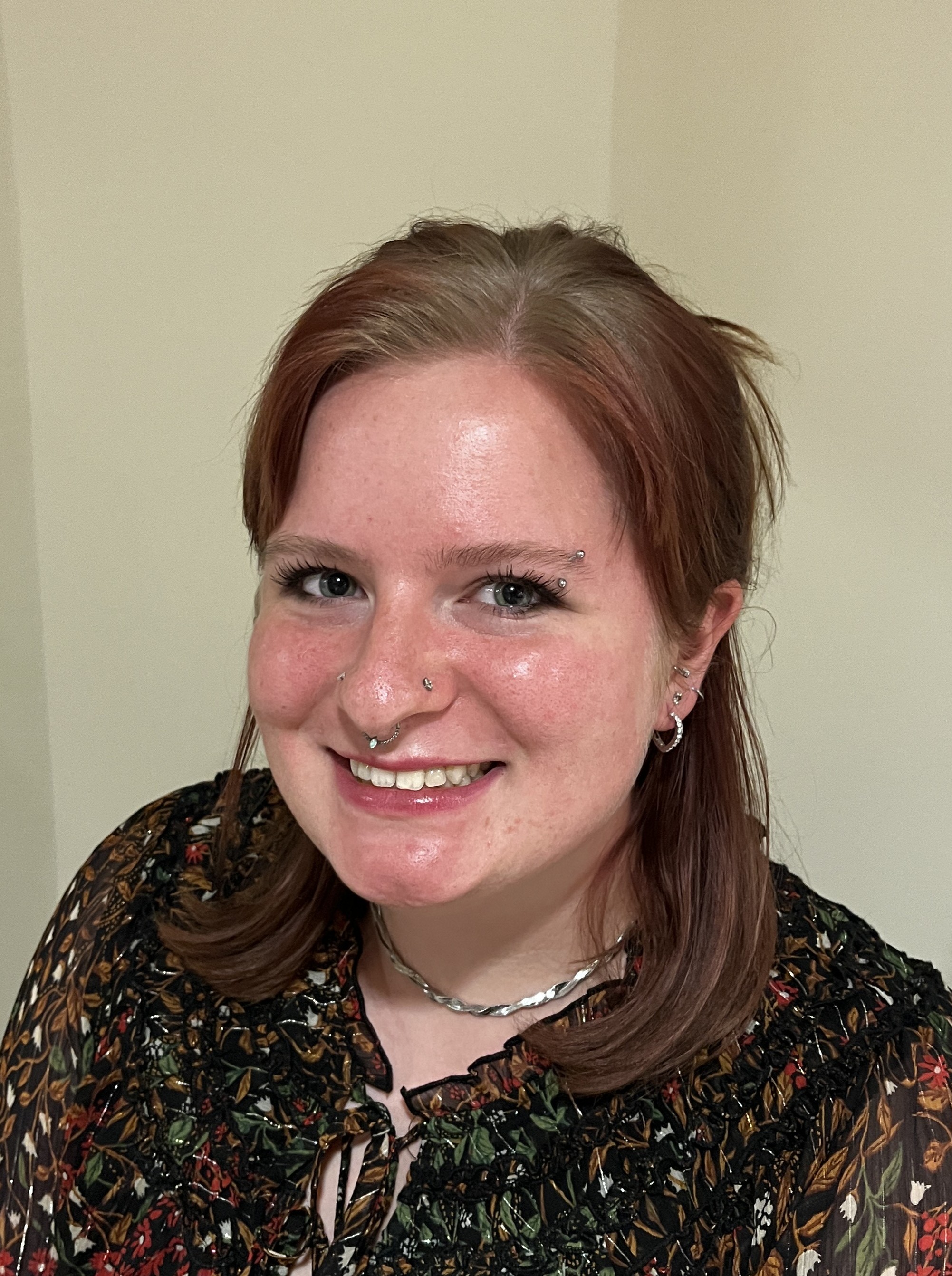
BIO
Bailey Underwood is a first-year English scholar at Florida State University pursuing a career in post-secondary education, writing, and/or publishing. She is involved in the International English Honors Society and History Club on campus. She also serves as a research intern for the Rosenstrasse Civil Courage Foundation. Bailey's absolute favorite hobby is reading. She is from the Pensacola area and loves the new home she has found in Tallahassee. She is a fierce cat-lover, DIY-er, and workaholic, and she is so excited to have the opportunity to present all of her hard work at the UROP Symposium!
The Ladies of Minnesang: Female Agency in Medieval Literature
Authors: Bailey Underwood, Laura BiagiStudent Major: English Literature, Media, & Culture
Mentor: Laura Biagi
Mentor's Department: English Department Mentor's College: College of Arts and Sciences Co-Presenters:
Abstract
Female figures in medieval troubadourian Minnesang lyrics are often characterized as powerless objects. They are placed into several inflexible roles that constrain their acceptable behavior, such as the courtly woman, the seductive shepherdess, and the passionate lover. By deconstructing male and female interactions in works by Walther Von Vogelwiede, Friedrich Von Hausen, and others, I argue these women develop agency over their male counterparts through their God-given beauty, sexuality, and supernaturality. I collected supporting information from lyrical poems by the medieval troubadours mentioned above and several academic articles by medieval scholars, most notably Dr. Will Hasty. Minnesang women achieve “gewalt,” or power, in three main ways. They possess irresistible beauty, often from God himself, that is distinctly feminine and unconquered by men. They make their own choices, consenting to or refusing “lon,” defined as an act of sexual repayment in gratitude to noble knights. Finally, a supernatural, domineering woman, Lady Minne, orchestrates the knight’s sexual courtship of his lady, violently forcing him into a relationship destined to fail. These findings suggest that medieval women- although they were restrained by social expectations and local legislation- used their inherently feminine traits as forms of power. My audience will find compelling comparisons between the roles of modern women and those of medieval women in historical and contemporary feminized forms of power, such as the establishment of the female gaze in beauty standards, the utilization of sex work as an income source, and the rise of female voices in acts of anti-patriarchal rebellion.
Keywords: Medieval, Literature, Poetry, Gender, Sexuality, Love
25th annual Undergraduate Research Symposium, April 1, 2025
Rachel Fine Poster Session 2: 10:45 am - 11:45 am/ Poster #246

BIO
Hello! My name is Rachel Fine, and I am an Exercise Physiology undergraduate student planning to attend Medical School in the future. I am currently apart of the undergraduate Research Opportunity Program, where I have been working under the Gut Biome lab at the college of Education, Health, and Human Sciences as a Research Assistant. I am born and raised from Tampa, Florida, where I attended Steinbrenner High School. I played softball (both travel and high school) for over 8 years, which has led me to love sports medicine.
Effect of Daily Watermelon Intake on Cardiometabolic and Gut Health in Young Adults with Overweight and Obesity
Authors: Rachel Fine, Cole PatoineStudent Major: Exercise Physiology
Mentor: Cole Patoine
Mentor's Department: Nutrition Mentor's College: Education, Health, and Human Sciences Co-Presenters: Amber Annand
Abstract
The Dietary Guidelines for Americans recommend eating 1.5-2.5 cups of whole fruit daily. Watermelon is rich in lycopene and L-citrulline, which support heart health. Lycopene, a strong antioxidant, helps reduce inflammation, improve blood vessel function, and increase nitric oxide (NO) production, which relaxes blood vessels through vasodilation. L-citrulline, an amino acid, boosts NO levels by increasing L-arginine, improving blood flow and lowering blood pressure. Together, these compounds may improve vascular health, but their combined effects in fresh watermelon are not well studied. This study aims to test how daily watermelon consumption for six weeks affects blood vessel function and stiffness in young adults with overweight and obesity. This small clinical trial includes ten participants (ages 18-30, BMI 30-39.9), randomly assigned to eat either 2.5 cups of watermelon daily or an isocaloric control snack (Belvita breakfast sandwich and water). Data will be collected at the start and end of the study. Key measures include blood vessel function, arterial stiffness, and blood pressure. Other factors like diet, weight, gut health, stress, sleep, and activity levels will also be tracked. This information applies directly to the recommended amount of whole fruit intake for day, which would prove a correlation in eating the daily value and better metabolic health. Since the target participants were obese people categorized in the BMI scale, the data can be used to encourage fruit intake to reduce overall weight.
Keywords: Nutrition, medicine, food


